My Review and Build of Trumpeter Kit #05309, 1/350 New Orleans Class
Heavy Cruiser, USS Vincennes, CA-45 REVIEW & BUILD, Doolittle Raid Vessel
Note: You can see all the pictures in highest resolution at My USS Vincennes, CA-44, Flickr Album, or you can cloick on any of the pictures here and get a higher resoultion image.
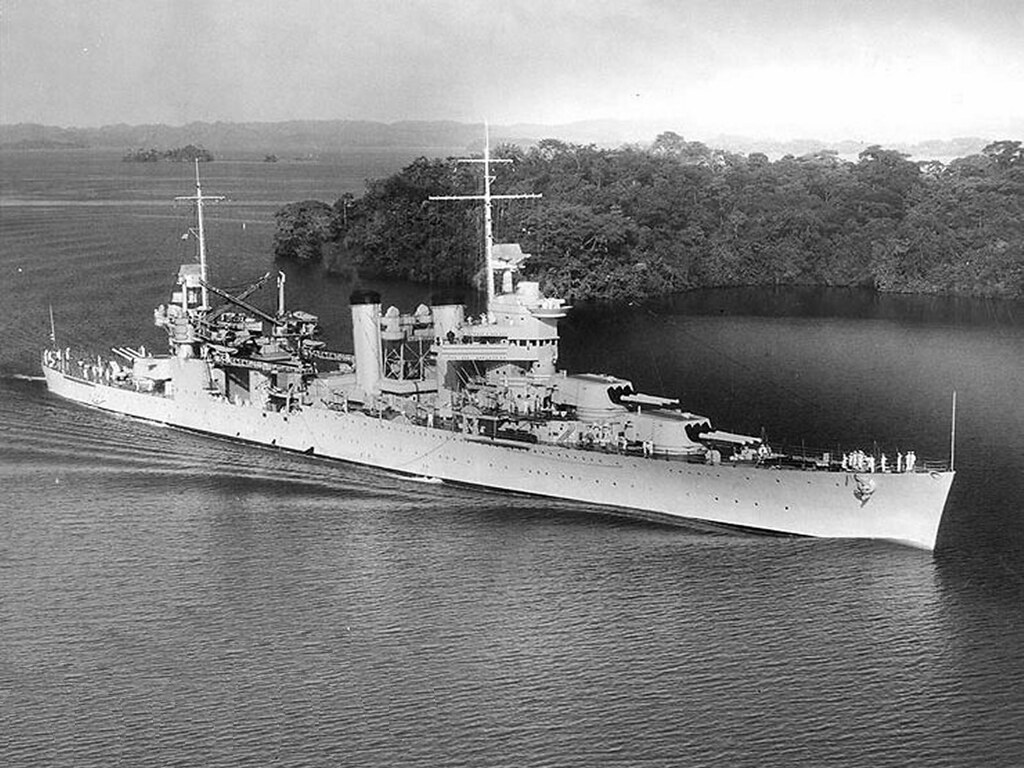
New Orleans Class Heavy Cruisers
The New Orleans-class cruisers were a class of seven heavy cruisers built for the United States Navy (USN) from 1933–36. All of them were put into commission bb 1938. They were succeeded by the Baltimore Class Heavy cruisers...but the first of those did not commission until several months after the Pearle Harbor, so the New Orleans class were the latest full clas of cruisers that the US had on hand to start the war, along with a couple of other older classes.
These were well built ships, that handled wel;l and were also well armed. They were the direct ancestor for all subsequent USN heavy cruisers. From them came the Brooklyn, Wichita, Cleveland, and the Baltimore-class cruisers. While the Washington Naval Treaty was still being observed, new technology was implemented in the New Orleans class because the USN knew that if and when war came, they would need this knowledge to build ships (which were already in the planning stage) beyond the treaty limits. The USN came to the conclusion that no 10,000-ton cruiser could adequately perform the roles given.
The New Orleans class displaced well over 12,000 tons full load.
As stated they were good ships and they fought well.
However, at the first Battle of Savo Island during the Guadalcanal campaign. three of them, the Astoria, the Quincy, and the Vincennes, accompanied by another cruiser, were suprised by a force of five heavy Japanese cruisers which had just sink one Australian heavy cruiser and damaged and run off another. The three New Orleans class were then set upon, and were defeated in line, one after the other. All three were sunk.
The US learned critical lessons from this debacle.
All he remaining four in class went through extenisve refits in 1942–43 which changed their appearance substantially.
The forward superstructure had the bridge wings cut back, and all of the large size windows were plated in with just a few port holes taking their place. The open bridge above the wheel house was enlarged by 100 percent by extending it forward. In addition several gun tubs were created for the 40 mm Bofors mounts both around the main mast, and aft.
The forecastle deck extended back to the second funnel and the main superstructure was constructed without the ungainly tripod mast seen on the previous cruisers. The bow was a raked type, similar to those of British cruisers. The two funnels were situated closer together with a large search light tower in between. Aircraft handling facilities were moved further aft and a larger second conning station erected above the hangar.
A single mainmast was erected there, between two huge pedestal cranes which handled both spotter planes and small craft. The main 8-inch turrets, although armored, were actually smaller with a more effective angular faceplate. By enlarging the forecastle deck, the secondary battery of 5-inch guns were mounted closer together, facilitating a more efficient ammunition delivery.
Power was provided by eight Babcock & Wilcox high-pressure steam boilers that produced 107,000 hp (79,800 kW) for the four Westinghouse gearing steam turbines. The turbines were shafted to four screws, giving this class a rated speed of 33 knots (61 km/h). The cruisers' range – using 3,269 long tons (3,321 t) of bunker oil – was approximately 14,000 nautical miles (26,000 km) at 10 knots (19 km/h) or 5,280 nautical miles (9,780 km) at 20 knots (37 km/h). Their range could be extended by refueling from a tanker or another ship fitted to transfer oil while underway.
The four remaining in class, USS New Orleans, CA-32, USS Minneapolis, CA-36, USS Tuscaloosa, CA-37, and USS San Francisco, CA-38, fought on through the war and survived. They were all struck in 1959 after over 30 years service, but also after becoming obsoloete in the missile age which the US Navy entered into.
Here were the specifications:
Displacement:
9,950 long tons (10,110 t) 12,463 long tons (12,663 t) (loaded)
Length: 588 ft 2 in (179.27 m)
Beam: 61 ft 9 in (18.82 m)
Draft: 19 ft 5 in (5.92 m)
Propulsion:
4 × Parsons/Westinghouse geared turbines
8 × Babcock & Wilcox boilers
4 × screws
107,000 hp (79,800 kW)
Speed: 32.7 knots (60.6 km/h; 37.6 mph)
Complement: 708 officers and enlisted
Armament:
9 × 8-inch/55 caliber guns
8 × 5-inch/25 caliber guns
4 x 4 40mm cannons
4 x 2 20mm cannons
8 × .50 caliber machine guns
Armor:
Belt 3–5 in (76–127 mm)
Deck 1.25–2.25 in (32–57 mm)
Turrets 1.5–8 in (38–203 mm)
Barbettes 5 in (127 mm) (6.5 in (165 mm) in CA-38)
Conning tower 5 in (127 mm)

USS Vincennes, CA-45
I am building this vessel as the USS Vincennes, CA-44, even though it was sold as the USS San Francisco, CA-38..
Vincennes was lai down in January 1934, launched in May 1936, and commissioned into the US Navy in February 1937. She was the last of the New orleans class and the last U.S. cruiser built to the specifications and standards of the Washington Naval Treaty of 1922. Such ships, with a limit of 10,000 tons standard displacement and 8-inch caliber main guns may be referred to as "treaty cruisers." Originally classified a light cruiser when she was authorized, because of her thin armor, Vincennes was reclassified a heavy cruiser, because of her 8-inch guns. At full displacement, because of additions given her, and because the US was suspecting that war was coming, she had a 12,500 ton displacement.
After commissioning, her shakedown cruise which took her to Stockholm, Sweden; Helsinki, Finland; Le Havre, France; and Portsmouth, England.
Early in January 1938, Vincennes was assigned to Cruiser Division 7 (CruDiv 7), Scouting Force, and steamed through the Panama Canal to San Diego, California. In March, the ship participated in Fleet Problem XIX in the Hawaiian area before returning to San Pedro, California for operations off the west coast for the remainder of the year.
Following an overhaul at the Mare Island Navy Yard which lasted through April 1939, the cruiser returned east, transited the Panama Canal on 6 June, in company with Quincy, Tuscaloosa, and San Francisco and anchored in Hampton Roads on the 13th. For the next two months, she operated out of Norfolk in the vicinity of the Chesapeake lightship and the southern drill grounds.
On 1 September 1939, the day when Germany's and Adolf Hitler's legions marched into Poland and commenced hostilities in Europe, Vincennes lay at anchor off Tompkinsville, New York. She then began conducting Neutrality Patrols off the east coast, ranging into the Caribbean Sea and the Yucatán Channel, and continued these duties through the spring of 1940.
Late in May, as German troops were smashing Allied defenses in France, Vincennes steamed to the Azores and visited Ponta Delgada from 4–6 June 1940 before she proceeded on for French Morocco. She was delayed in the Azores for three days while her code machine was repaired. While at anchor at Casablanca, the ship received word of Italy's declaration of war upon France, the "stab in the back" condemned by President Franklin Roosevelt soon thereafter. Vincennes' commanding officer — Captain John R. Beardall (later to become Naval Aide to the President) — noted subsequently in his official report of the cruise that "it was apparent that the French bitterly resented this and despised Italy for her actions." After departing North African waters on 10 June, the cruiser returned to the United States and returned to condcutng Neutrality Patrols.
Overhauling at Norfolk Navy Yard, Portsmouth, Virginia, into the first week of January 1941, Vincennes departed Hampton Roads on 7 January, in company with Wichita, New York, and Texas, bound for Guantánamo Bay, Cuba. Operating once again in the Caribbean, the heavy cruiser fired battle practice and gunnery exercises in company with Wichita through 18 January, when the two cruisers proceeded for Portland Bight, Jamaica. Conducting Neutrality Patrols from this port, Vincennes patrolled in company with other ships safeguarding neutral waters and America's recently acquired Caribbean bases.
Vincennes joined other Fleet units for landing exercises at Culebra, Puerto Rico on 4 February 1941 and sent her 50 ft (15 m) boats to assist in unloading and troop debarkation drills. She assisted transports McCawley and Wharton in landing men and material before taking station with Fire Support Group II. The cruiser then fired simulated gunfire support operations with her main and secondary batteries in exercises which foreshadowed her future combat role in the South Pacific.
Vincennes ruised off of Cape Town South Africa in early December 1941, an departed South African waters on the 16th, bound, via Trinidad, for Hampton Roads. During this transit, war borke out with the bombing of Pearl Harbor.
Following her arrival at Norfolk on 4 January 1942, she shifted to New York four days later to be outfitted for war. Late in the month, she joined Hornet as the carrier conducted her shakedown training off the east coast of the United States. This brings her to one of the principal reasons I am building this model. She stuck with the Hornet, and joined her in the bold plan to attack Tokyo early in 1942.
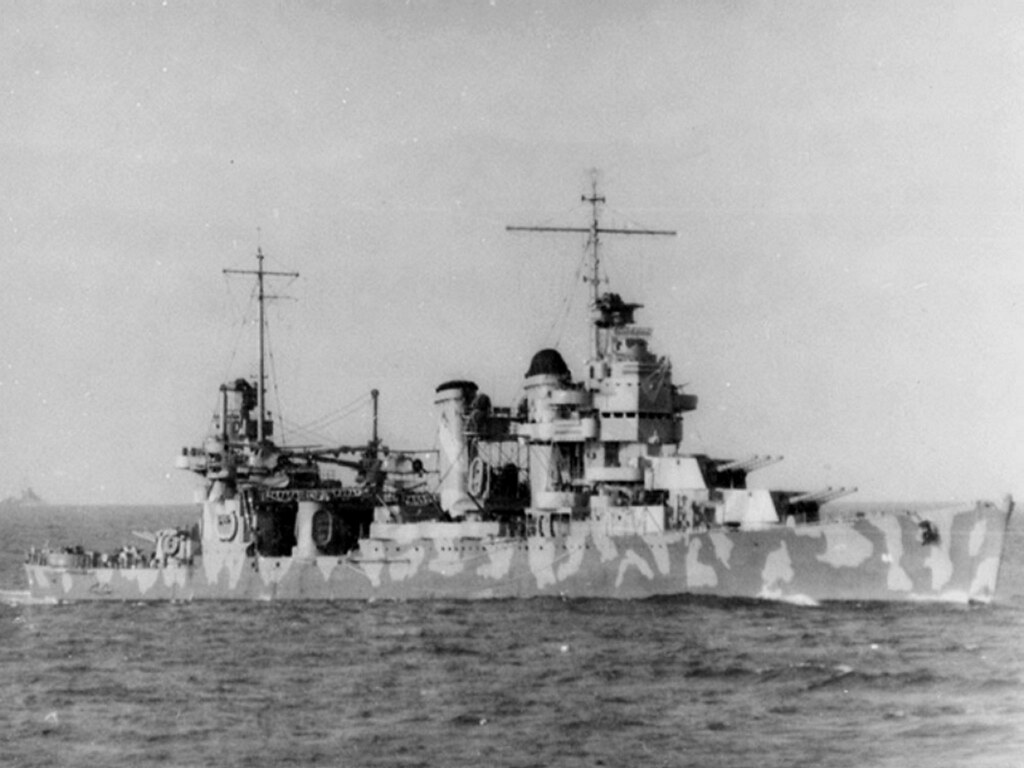
Doolittle Raid on Tokyo:
She was one of four Cruisers that served with the USS Hornet, CV-8 (TF-18), and USS Enterprise, CV-6 (TF-16), during this first offensive strike at Japan, during the Doolittle Raid on Japan in April 1942.
I am building a 1/350 scale group of ships representeive of that raid including: CV-8 USS Hornet aircraft carrier
USS Enterprise, CV-6, aircraft carrier
USS Vincinnes CA-44, Heavy Cruiser
USS Grayson, DD-435, Gleaves class destroyer
There wer actually 16 ships in the task force which was the largest group the US Navy could put together after the many ships sunk and damaged in Pearl Harbor, and represented a tremendous risk for the United States at the time.
But the risk paid off, and alothough they had to launch early because of being sighted by Japanese picket boats, the bombers surprised the Japanese and the task force eluded being intercepted by the Imperial Japanese fleet.
The combined Enterprise and Hornet task force retired eastward and made Pearl Harbor on 25 April. Departing again five days later, the ships, still screened by Vincennes, bent on speed toward the Coral Sea. However, they were too late to take part in the Battle of the Coral Sea.
Batttle of Midway:
Vincennes' task force returned to Pearl Harbor on 26 May but got underway again on the 29th, bound for waters off Midway Island, which, according to American intelligence reports, a Japanese invasion force was approaching. By 4 June, the heavy cruiser had joined TF16 and was steaming north of Midway.
After American air attacks had crippled three of the four Japanese carriers the Vincennes, together with the cruiser Pensacola and destroyers Benham and Balch was sent over to TF17 to reinforce the carrier Yorktown after it had suffered damage in a dive bombing attack.
At 1640, a group of Nakajima B5N "Kate" torpedo bombers from Hiryū approached from the north. TF 17's radar soon picked them up 15 mi (24 km) out, and Yorktown launched planes to intercept as her screen deployed to bring an optimum concentration of anti-aircraft fire to bear upon the approaching enemy. Three minutes after the first plane was spotted, Grumman F4F Wildcats from the carrier hit a "Kate". The Japanese torpedo plane spiraled from the sky trailing a long streamer of smoke before crashing into the sea.
Vincennes opened fire at 1644 with her 5 in (130 mm)/25 cal, 20 mm, and 1.1 in (28 mm) anti-aircraft batteries. Increasing her speed to 25 kn (29 mph; 46 km/h) and slowly turning to starboard, Vincennes kept her port guns trained on the enemy. While avoiding torpedo tracks, Vincennes hit a "Kate" and it went into the sea 150 yd (140 m) off her port bow.
The sharp, bitter action ended as quickly as it had begun. The Japanese had been driven off, but at a high cost. Yorktown, mortally hit and listing to port, slowed to a halt. Vincennes followed Astoria around the carrier, screening from further air attacks. However, on 6 June, a Japanese submarine, I-168, slipped through a screen of six destroyers and torpedoed Yorktown and Hammann, sinking the latter. The carrier went down early on June 7th.
Returning to Pearl Harbor, Vincennes entered the navy yard for repairs and alterations which lasted until early July. She then conducted tactical exercises off the island of Hawaii with other ships of TF 11 before departing Hawaiian waters on 14 July to rendezvous with TFs 16, 18, and 62...bound for Gualdalcanal and the fate of Vincinnes and two other New Orleans class cruisers.
Fighiting around Guadalcanal:
Screening for transport squadron "X-ray", slated to participate in the Guadalcanal landings, Vincennes, in company with San Juan and Quincy, joined TF 62 on 26 July. On the 27th, the cruiser conducted approach exercises for landing practice and simulated bombardment drills off Koro Island in the Fiji group. As flagship for Task Group 62.3 (TG 62.3), Vincennes remained on station in the covering force in the transport area before undertaking further approach and landing exercise support drills.
Following replenishing, the heavy cruiser formed up with the American armada making its way to the Solomon Islands. Vincennes, screening transport division "Yoke", arrived off Guadalcanal on 7 August. At daybreak, beneath overcast skies, the ship catapulted her scout planes and then unlimbered her main and secondary batteries to commence shore bombardment. While the thunder of the supporting ships' gunfire reverberated across the waters, marines disembarked from their landing craft and stormed ashore to meet initially light resistance on the island.
Shortly after 1320, Japanese planes launched a counterstrike. To sunward of the transports, Vincennes found herself in a favorable position to combat the attack and tracked the opposing planes, being among the first ships to open fire on the attackers. Forced to jettison their deadly loads prematurely, the Japanese retired without doing any damage, but not before Vincennes had bagged two of them. After sunset, Vincennes, Quincy, and Astoria, in company with Helm and Jarvis, retired to conduct screening patrols.
Returning to her covering duties at daylight, Vincennes arrived at transport area "X-ray", off Guadalcanal by daybreak. Two minutes before noon, Japanese bombers, intent on avenging their losses of the day before and disrupting the American landing, swooped down from Rabaul. 27 Mitsubishi G4M "Betty" bombers swept in, in a low-level torpedo attack and ran a gauntlet of gunfire from the transports and their escorting cruisers and destroyers. 3,000 yd (2,700 m) from the transports, Vincennes, as in the previous day's action, was again in favorable firing position and opened up with every gun in her battery, from 8 in (200 mm) to 20 mm, that could bear on the attackers.
During the ensuing melee, the cruiser used her 8 in (200 mm) guns effectively, helping to down at least seven "Bettys" which flew at an altitude of only 25 to 50 ft (7.6 to 15.2 m). The shell splashes from the main battery caused Japanese pilots to fly into walls of water or forced them to drastically alter their approaches. Vincennes dodged one torpedo which passed beneath her stern and evaded a bomb which fell off her port quarter. Jarvis, adjacent to the cruiser, took one torpedo hit which ultimately proved fatal to the ship
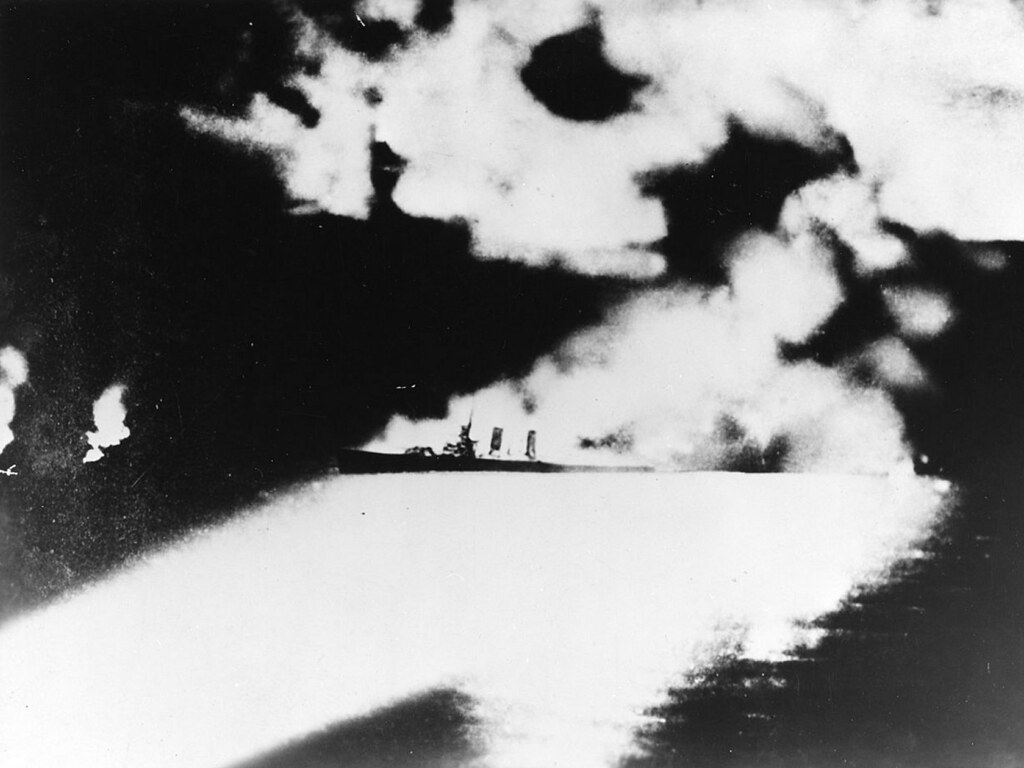
Battle off Savo Ilsand:
At about midnight on 8 August, Riefkohl retired to his sea cabin, adjacent to the pilothouse, after having been on the bridge continuously since 0445 that morning. Turning in at 0050 on 9 August, he left his ship in the hands of the executive officer, Commander W. E. A. Mullan.
Nearly an hour later, at about 0145, lookouts spotted flares and star shells to the southward, accompanied by the low rumble of gunfire. The sound of the general quarters alarm soon rang throughout the ship and stirred her to action. Vincennes' lookouts were seeing the elimination of the southern escort group, based around HMAS Canberra and Chicago. Unbeknownst to the men manning the ships to the northward, a powerful enemy force was heading in their direction. Six cruisers and one destroyer under the command of Vice Admiral Gunichi Mikawa had turned north and were steaming directly towards Vincennes and her two sisters.
The first Japanese cruiser searchlight beams illuminated Vincennes's shortly after 0155, and the American cruiser opened fire with her main battery at the troublesome lights. Within a minute, however, Japanese shells bracketed the ship and Vincennes shuddered under the impact of Japanese eight-inch armor-piercing shells. The bridge, carpenter shop, "battle II," and radio antenna trunks all were hit by the first salvo.
Altering course to port, Riefkohl, who had come to the bridge at the alarm, rang down for increased speed. With the ship and internal communications disrupted, it is doubtful that the order was received. Still moving at 19.5 kn (22.4 mph; 36.1 km/h), the heavy cruiser reeled under the impact of another group of direct hits.[4]
Some of the shells in this group set fire to the volatile aircraft in Vincennes' hangar space, and the resultant flames became uncontrollable. A direct hit knocked the aft antiaircraft director overboard. At 0200, Vincennes heeled to starboard in an attempt to evade enemy gunfire, only to be hit by Japanese torpedoes. One or two "Long Lance" torpedoes ripped into the ship's number 4 fireroom and put it out of action.[4] In moments the report came "Both engine rooms are black and dead."
Having lost power and all steering control five minutes later, Vincennes was dead in the water within minutes. The glare of burning fires attracted additional incoming shells which quickly put the ship's own guns out of action. Vincennes shuddered to a halt. Hit at least 85 times by 8 in (200 mm) and 5 in (130 mm) shells, the ship gradually began to list.
At 0210, the Japanese retired, leaving Savo Island and the burning hulks of three American cruisers in their wakes. As Vincennes' list increased to port, Riefkohl issued the order to abandon ship at 0230. Serviceable life jackets and rafts were broken out, and the crew began abandoning ship. At 0240, the captain went down to the main deck and jumped into the tepid waters of what would come to be known as Ironbottom Sound. 332 crewmen did not survive and are officially recorded as killed in action in the loss of the Vincennes.
Riefkohl subsequently wrote: "The magnificent Vincennes, which we were all so proud of, and which I had the honor to command since 23 April 1941, rolled over and then sank at about 0250, 9 August 1942, about 2½ miles east of Savo Island … Solomons Group, in some 500 fathoms [910 m] of water."
Ths ended the career of the USS Vincennes, CA-44. what was learned from that final battle was turne to good in the United States, as future cruisers and future tatics made good use of the disasterous information.
Within months and the major naval battle of Guadalcanal, the US forces overcame the Japanese, retained Gualdalcanal, and then began pushing Japanese forces back in late 1942 and through 1943.
There was heavy fierce fighting to come, and others in the class were severely damaged. Here is one that came through a battle victorioes with other US Navy vessels, even th0ugh most of its bow was blown away in the fighting...but she was repaired and went on to fight throughout the war:

And so it was, the US Navy was on the offensive thrafter. The Battle fo Miday and the eventual victory around Gualdalcanal ensured this...including the loss at Savo Island.
Introduction and What's in the Box - March 24, 2017
This Trumpeter Kit is actually for the USS San Franciso, which survived the war. it comes with 10 sprues, nine in gray and one in clear for the float planes. All in all there are upwards of three hundred pieces for the model.
Tt comes with many detailed and small plastic parts which have been very finely molded, and are very detailed. The 50 caliber armor protection on the guns is molded so well and thin that using photo etch parts for them would not be necessary.
I am building her out of the bow and not adding photo eth...though I may find some railing for the lon runs around the bow and te stern areas later.
As I said, like most trumpeter kits, there are any, many fine details. One will have to be patient with these parts in orde to put the vessel together properly, but it looks like it will make a very nice kit.
The instructions are very well done on sixteen pages. The kit also comes with a full color, glossy paint guide.
You can build the vessel either as a waterline kit or full hull. I always choose full hull when I can.
The decals are well done too, tbut like most world war II US Navy vessels, there are very few and I had to use other decals for the "44" pennant number since it came with the San Francisco numbers.
All in all, this is a very good Trumpeter model and will make for a very good build.
Here's how the kit looked out of the box:
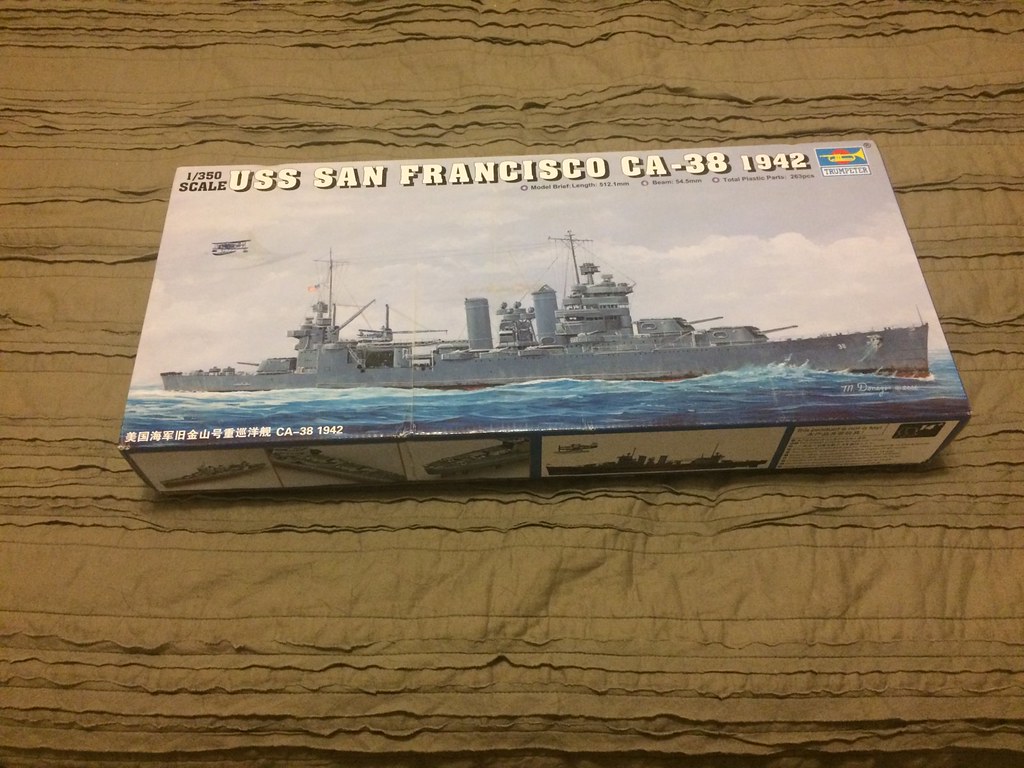
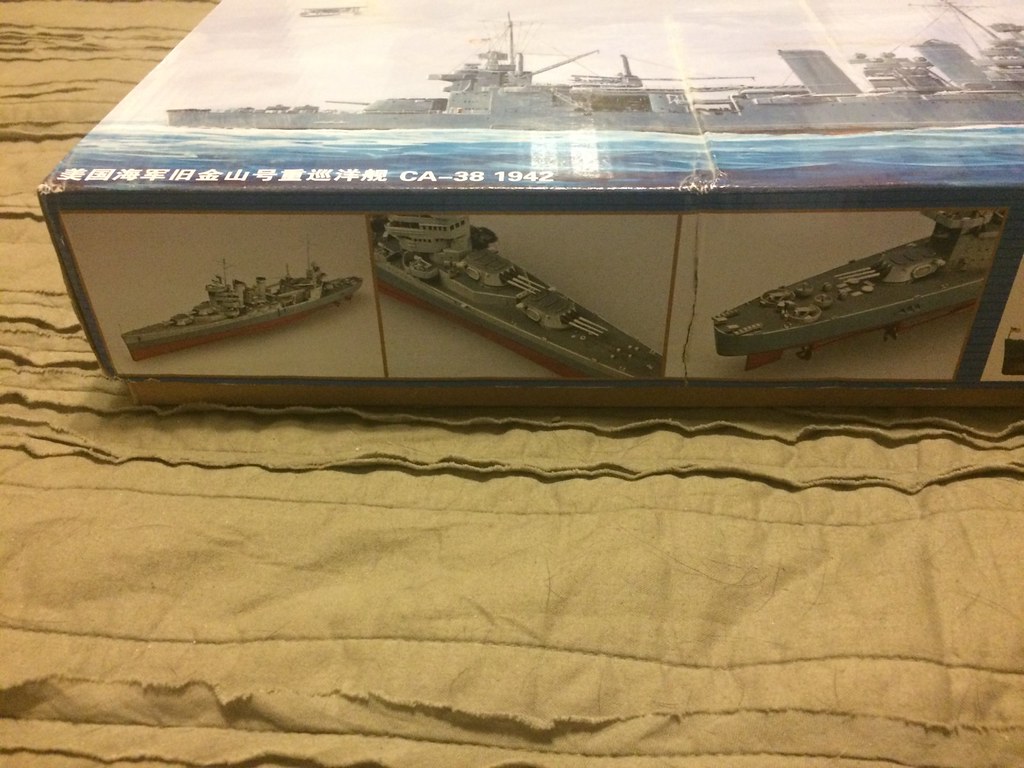
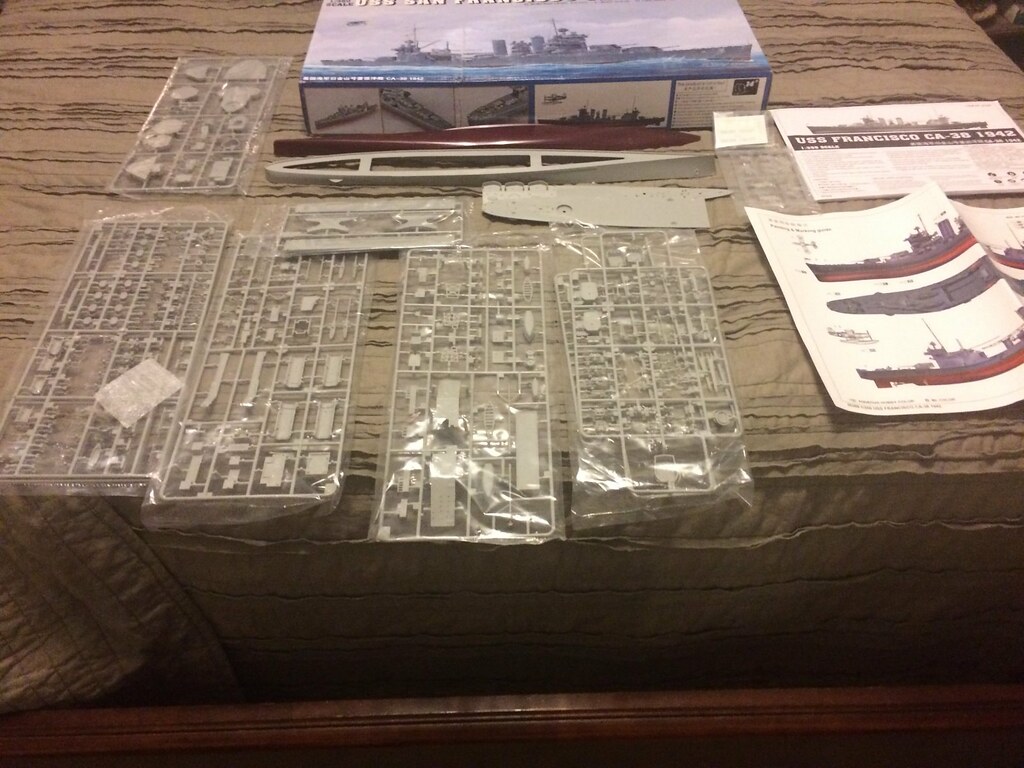

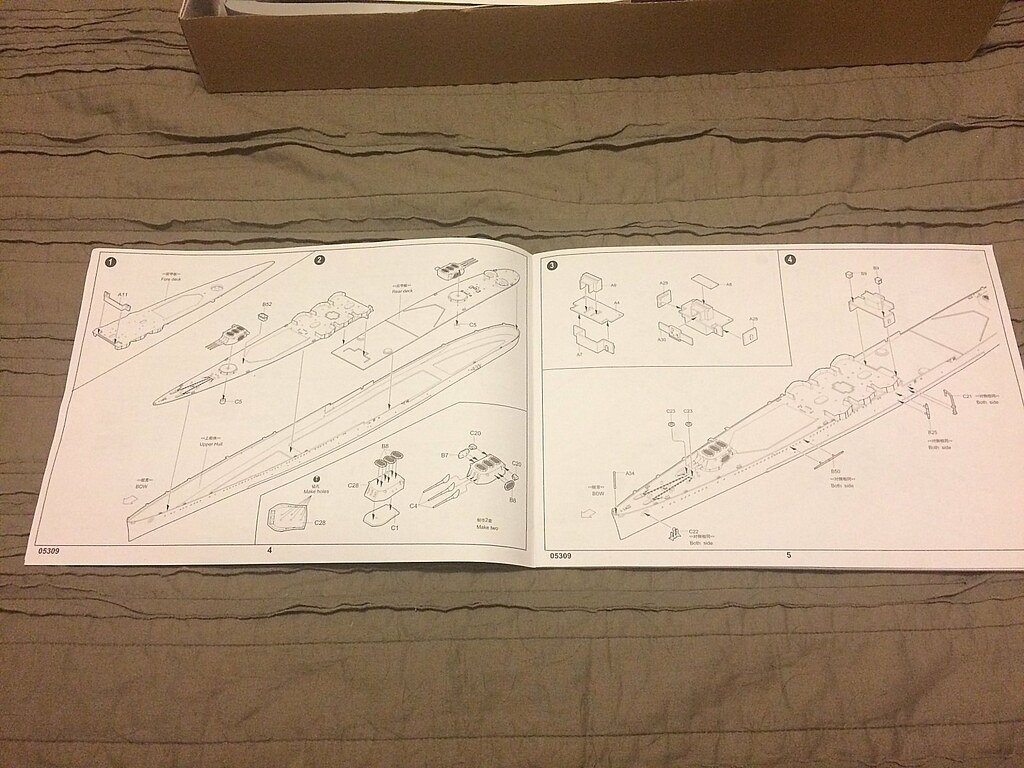
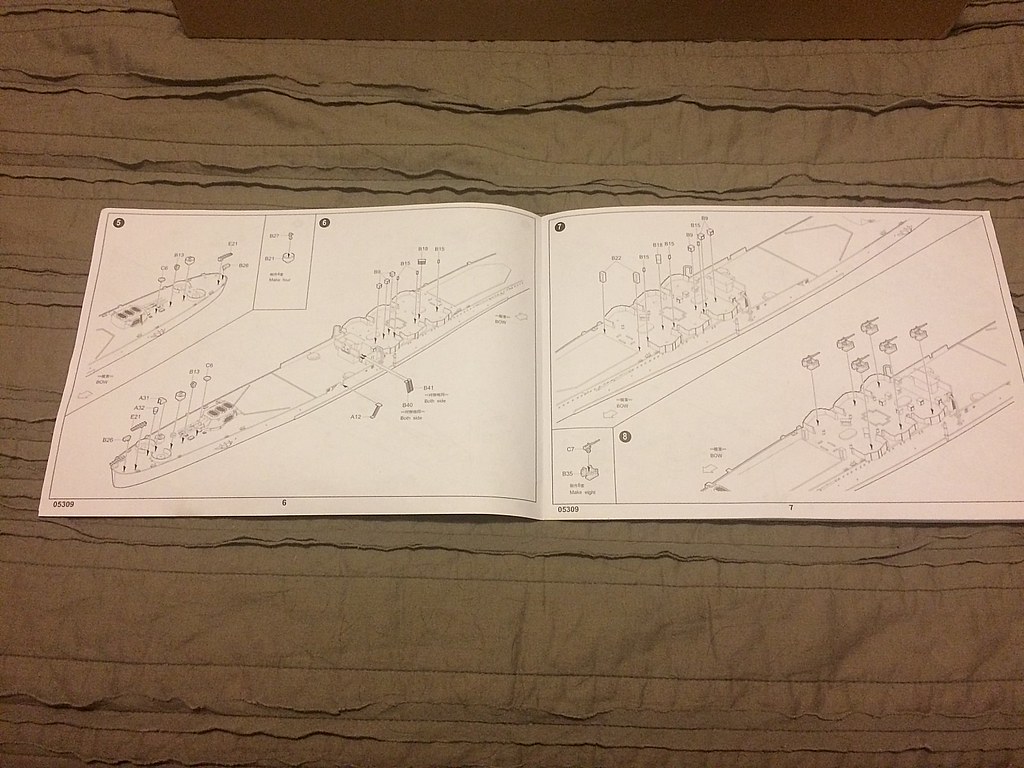
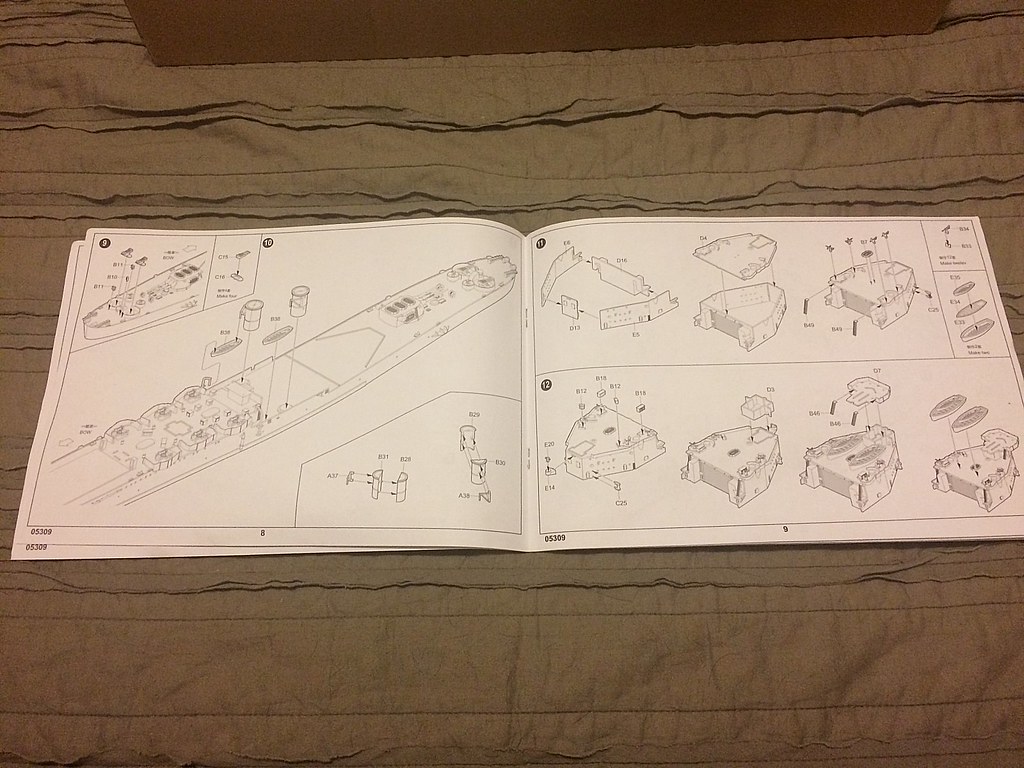
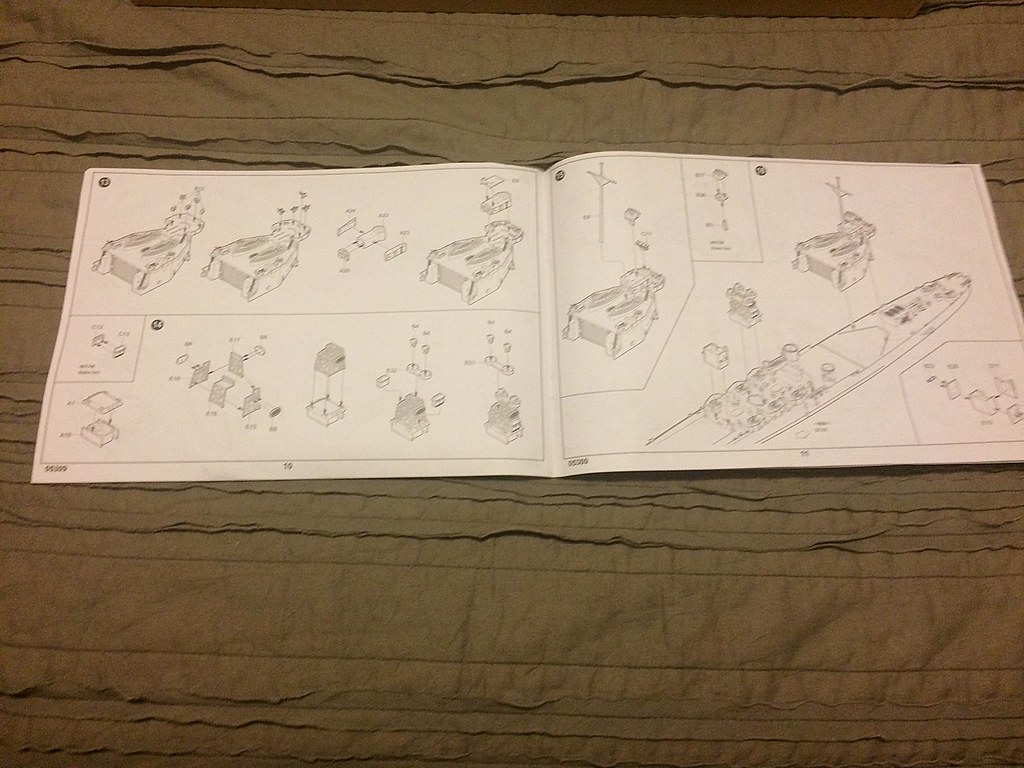
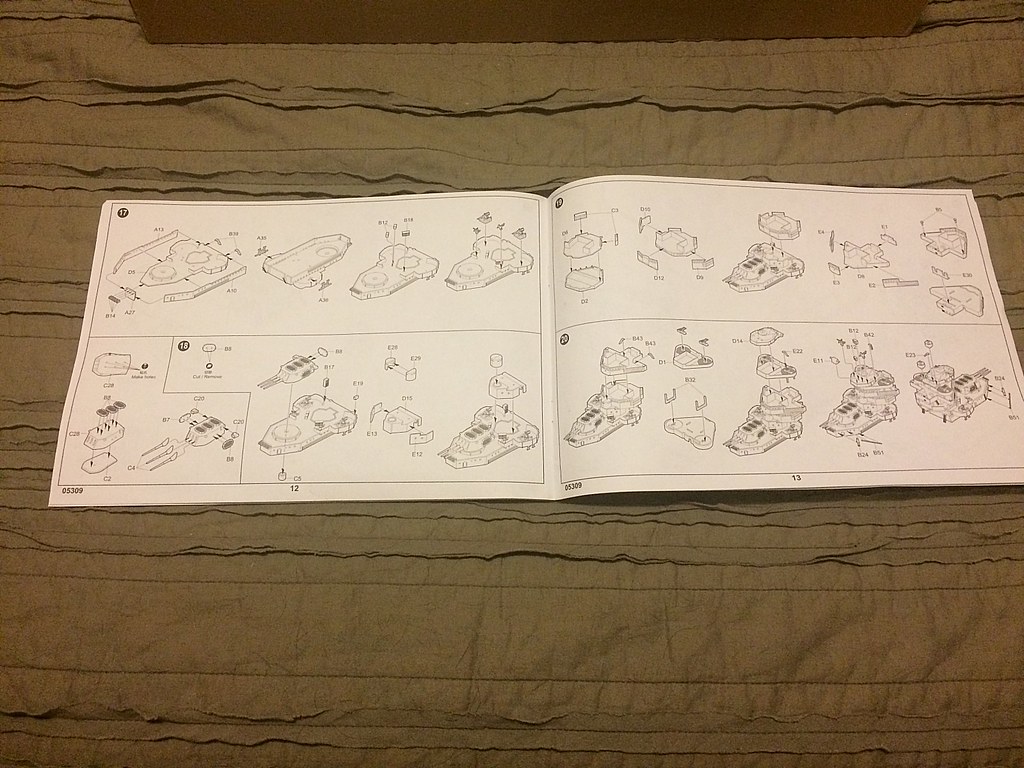
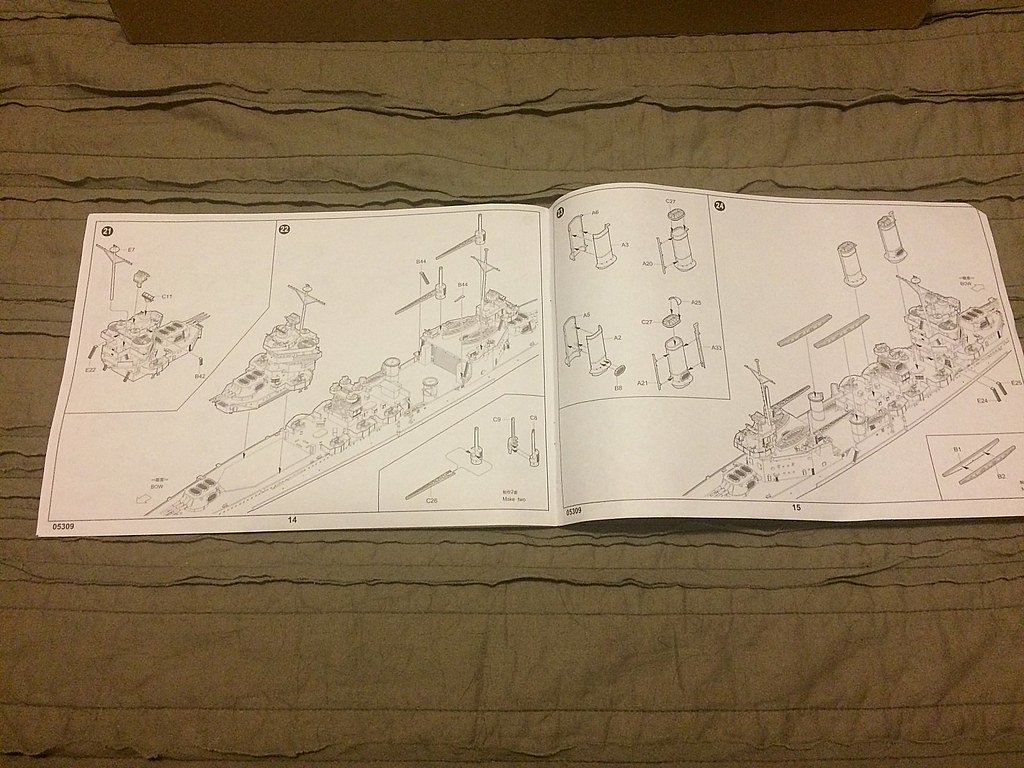
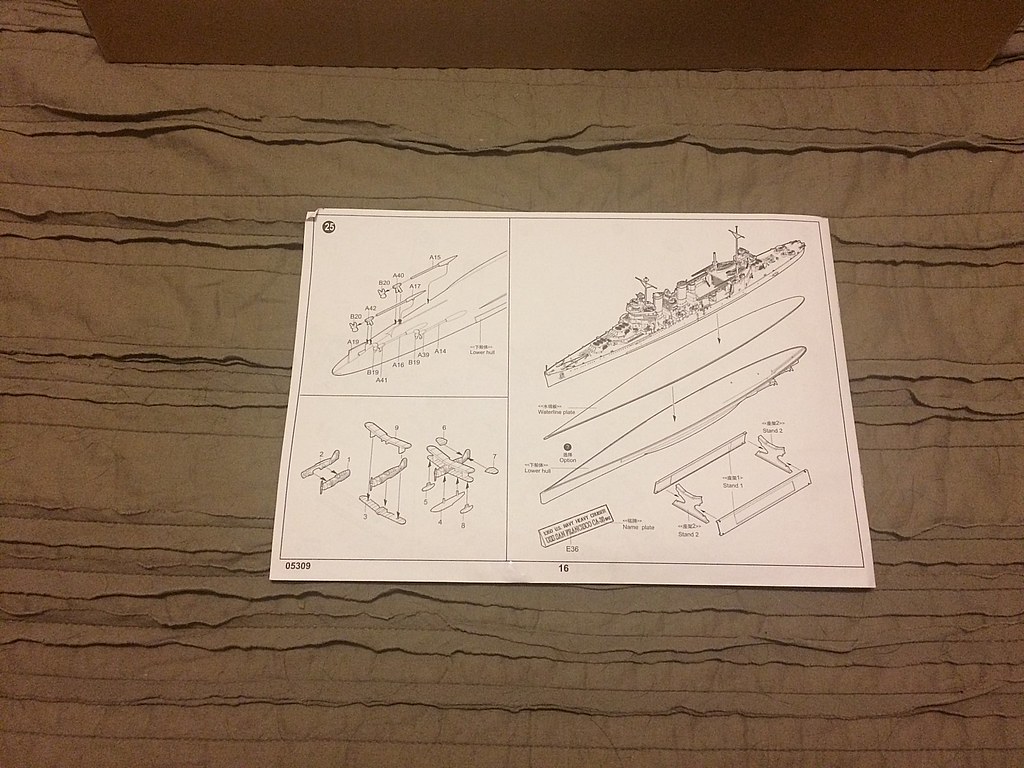
The Build - Lower Hull and props, upper hull and main decks - March 24, 2017
I started off by adding the props, supports, and rudder, and then painting the lower hull. I then painted the upper hull in neitral gray and then amsked off and painted the water line mark.
I then painted the main deck in a dark gray and added it to the upper hull, and then glued the two haleves of the hull together.
Here's how that all went:
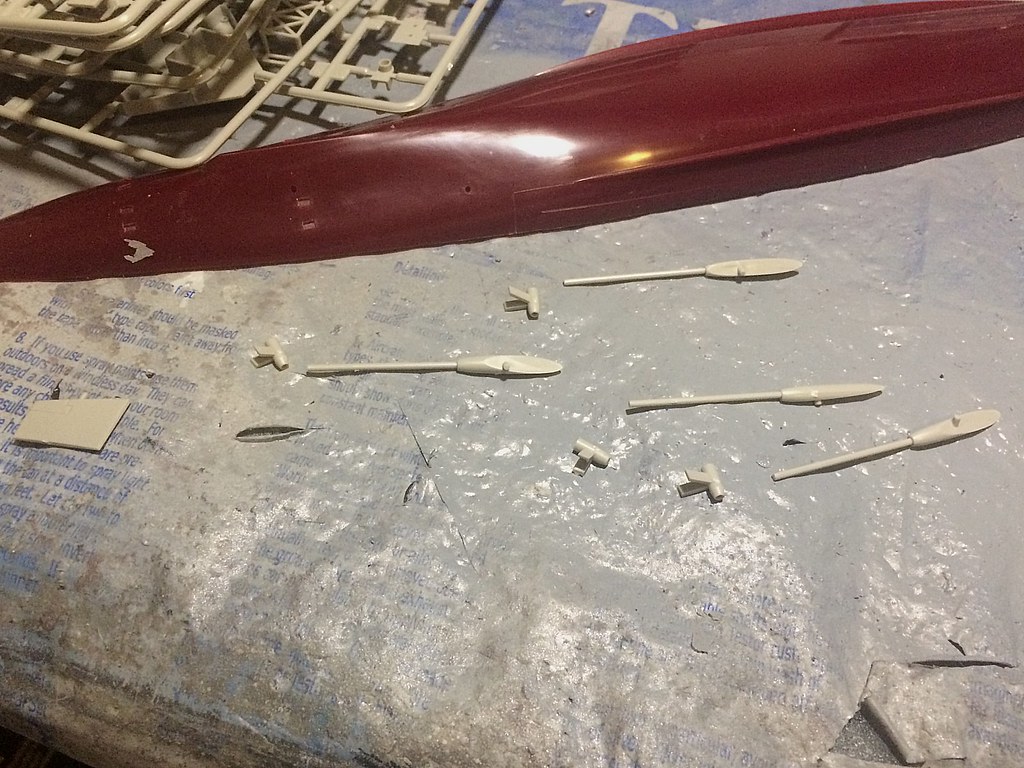
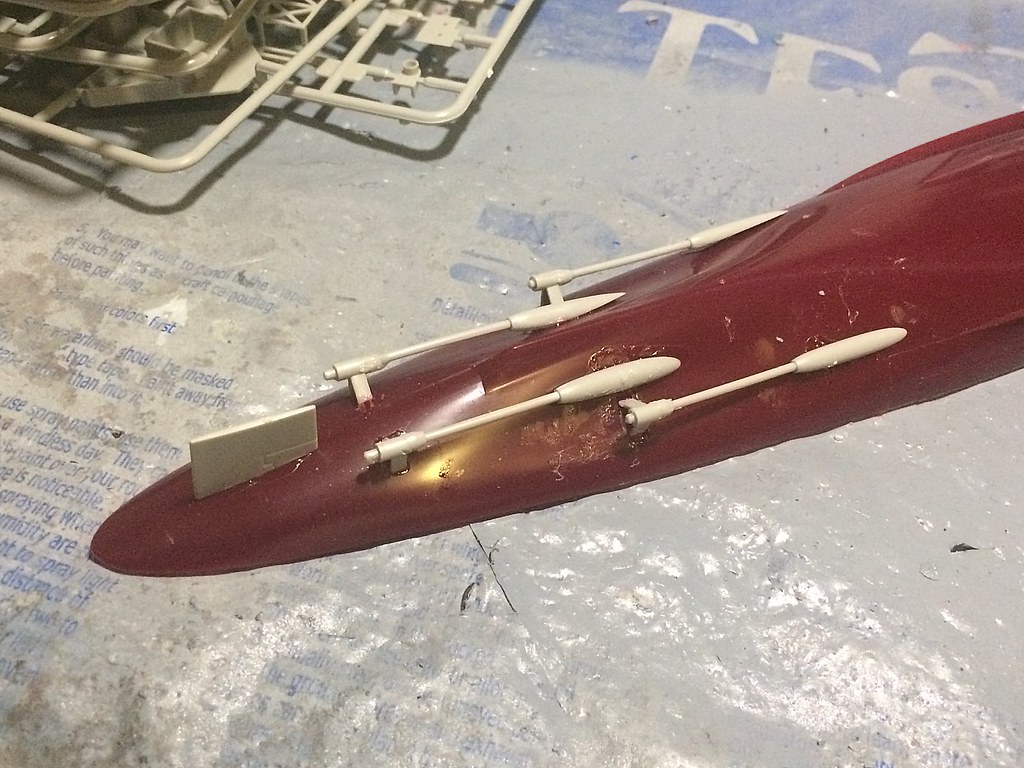
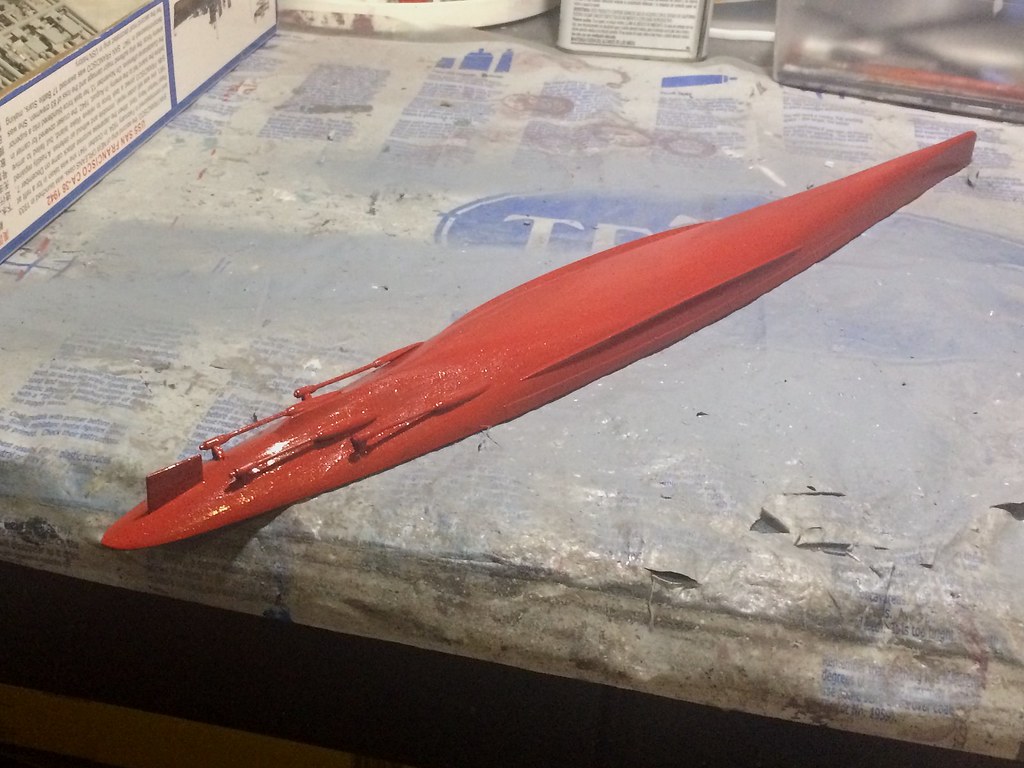
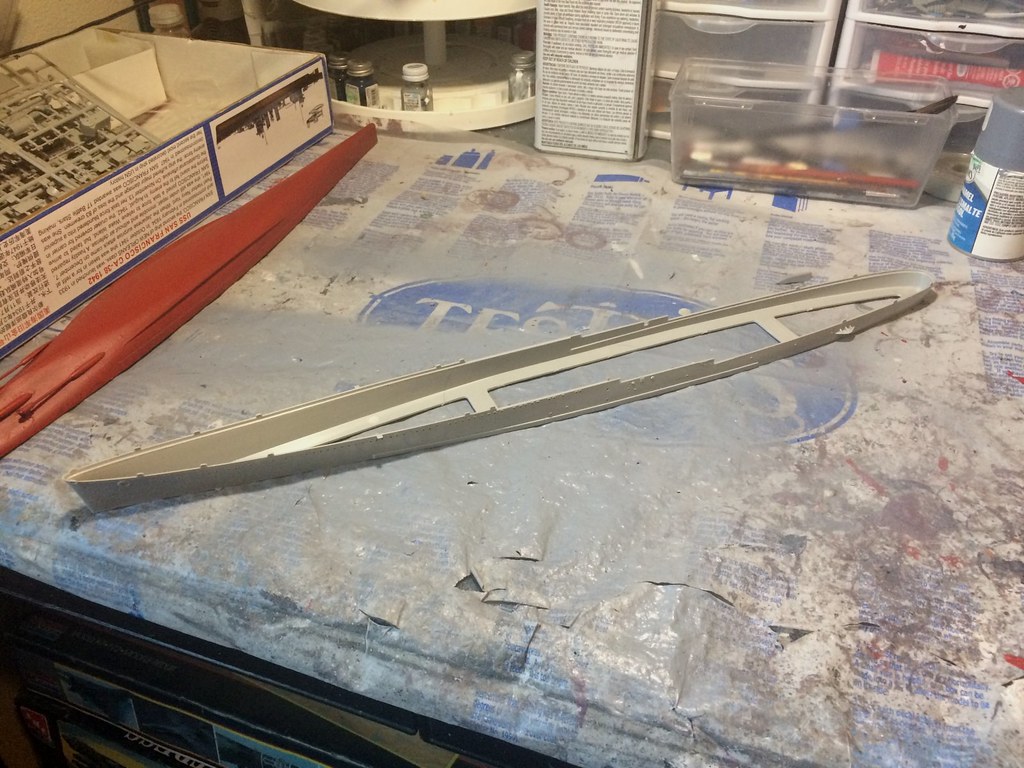
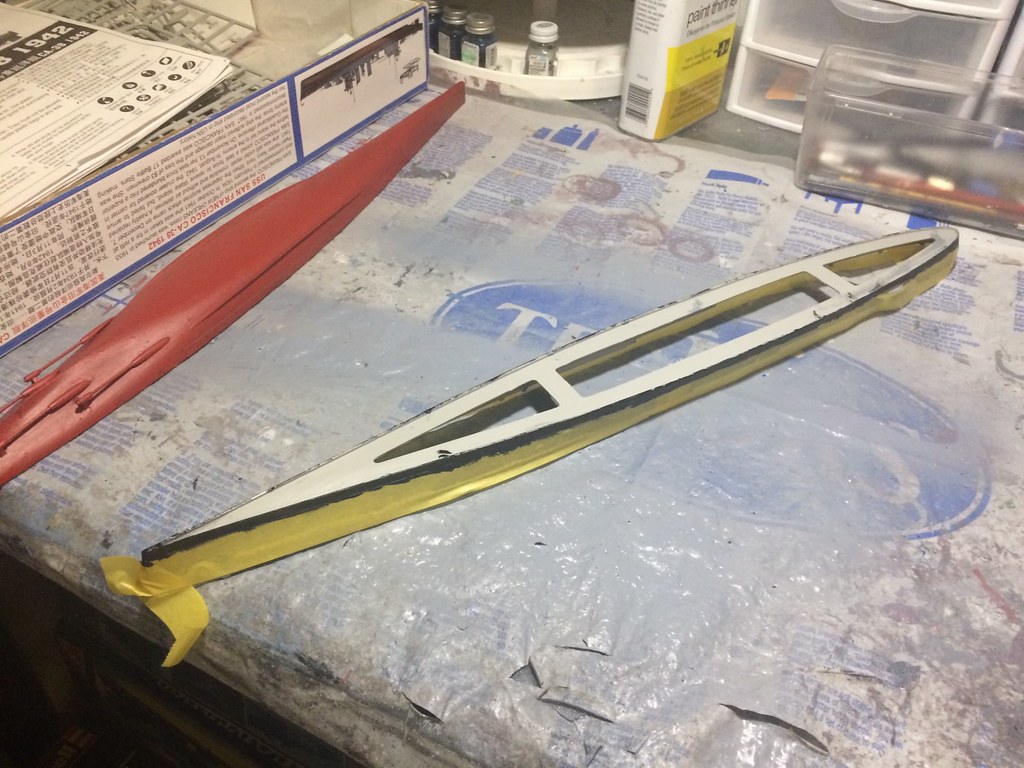

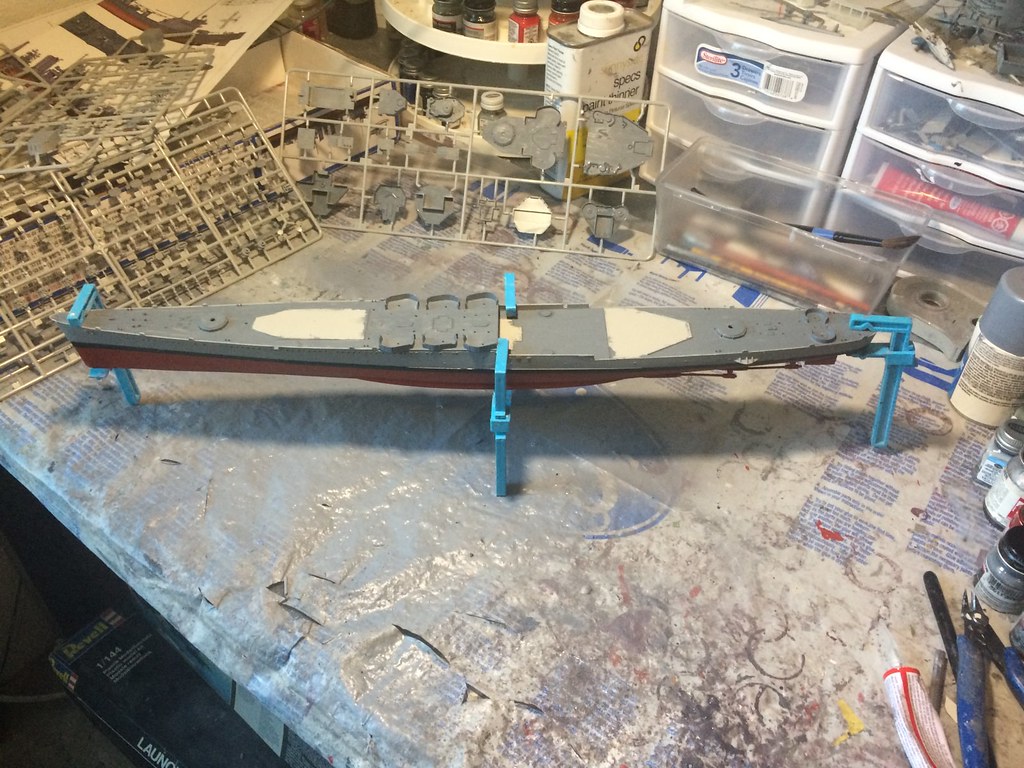
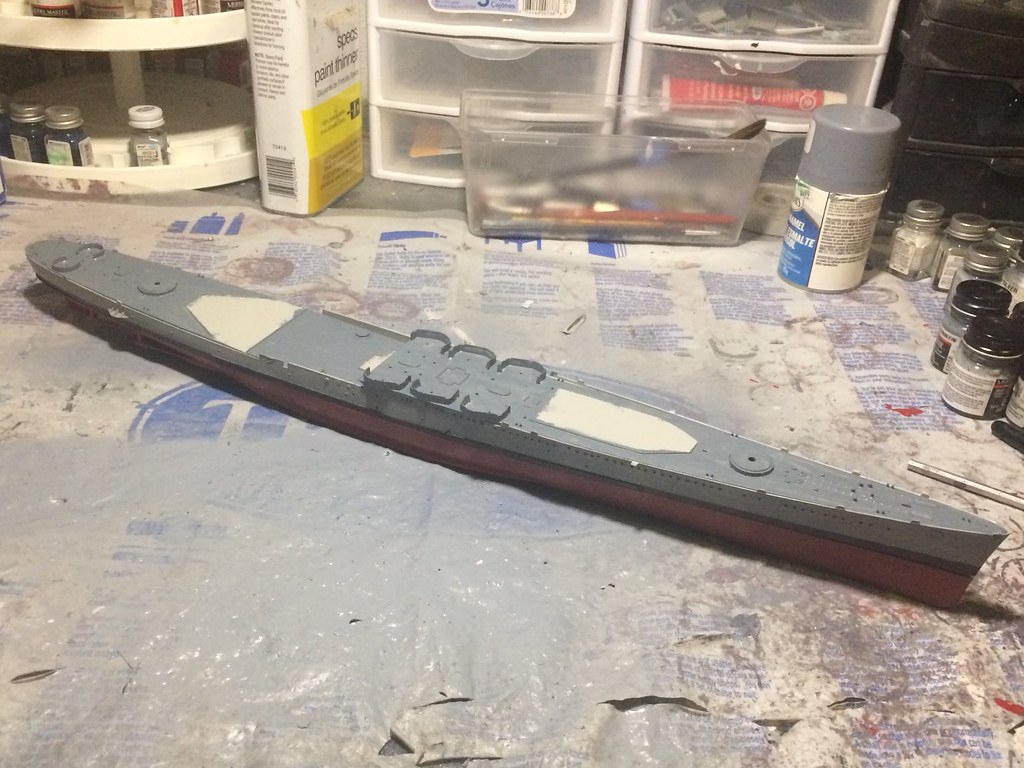
The Build - Aft deck house and hangar, forward deck house, and funnels, funnels, and main armament - March 26, 2017
Next I built the aft deck house. This also covers the large hangar for the four float planes the vessel carries. I added the cranes and the ships launches/boats.
I then built the foreward deck house and bridge, which also holds one of the forward, triple nine inch gun mounts.
I then added the two funnels amid ships wityh the large spotlight structure between the two funnels.
Here's how that looked. The decks are a dark gray and vertical surfaces nuetral gray. I will add the camo pattern later.
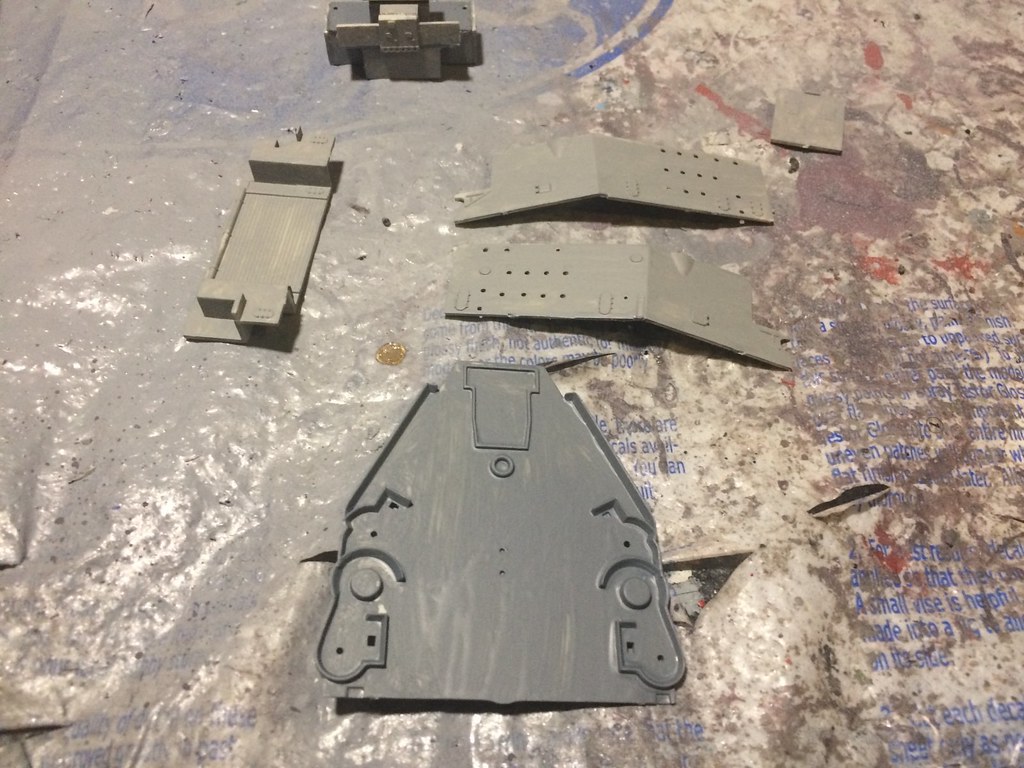
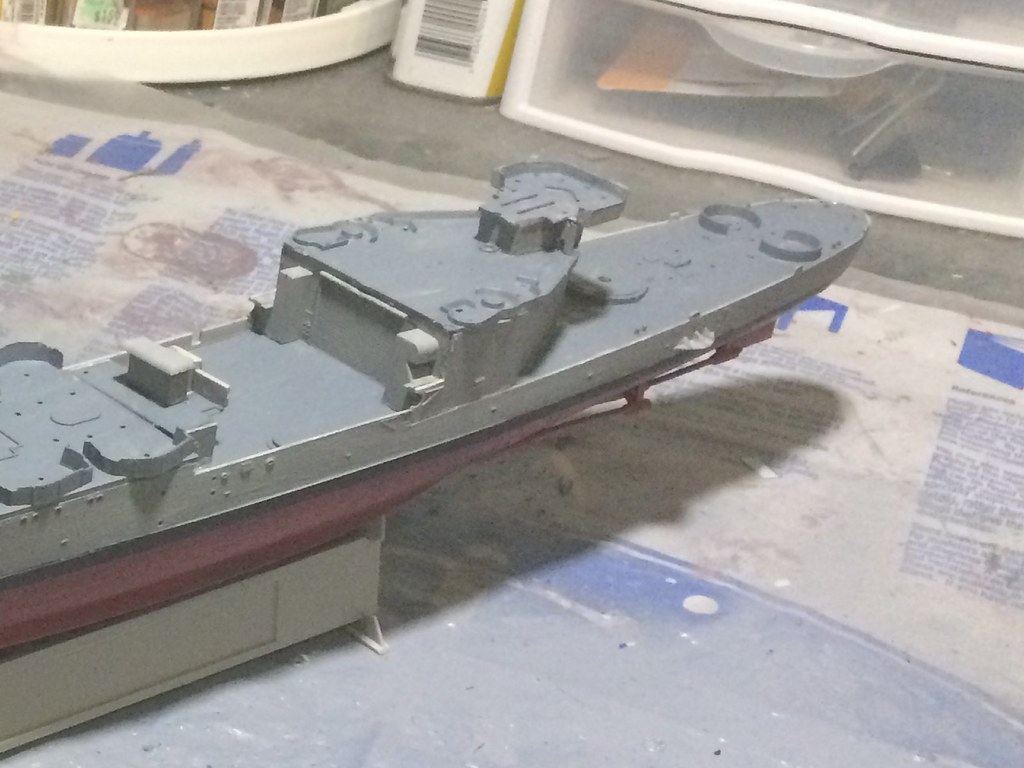
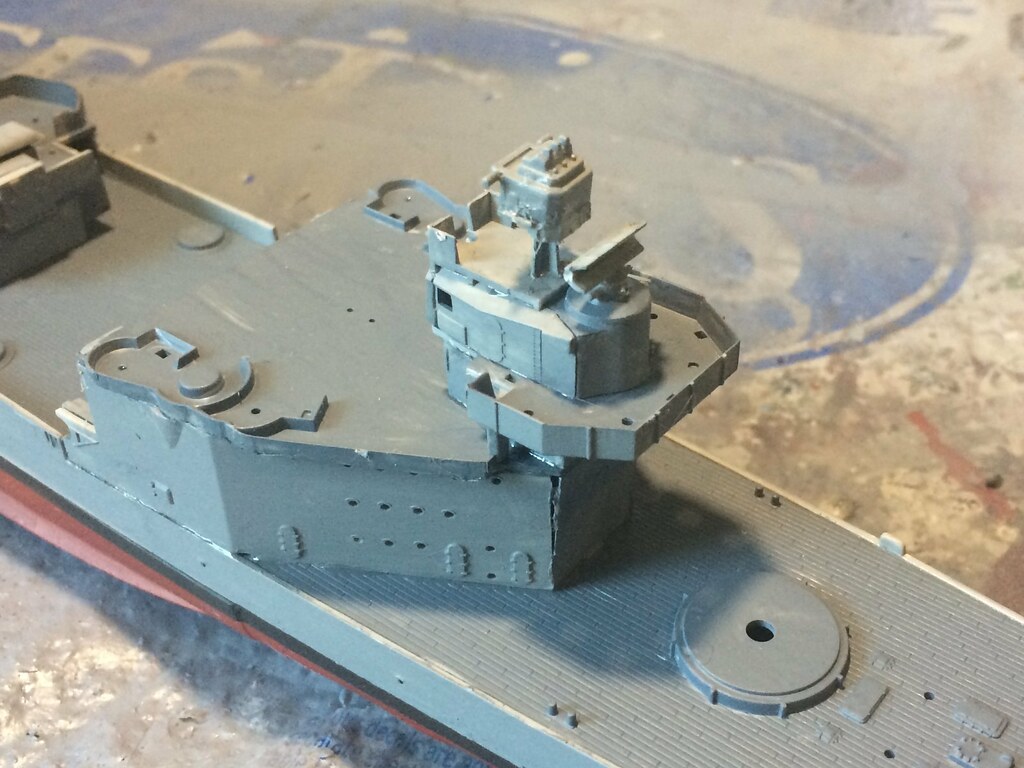
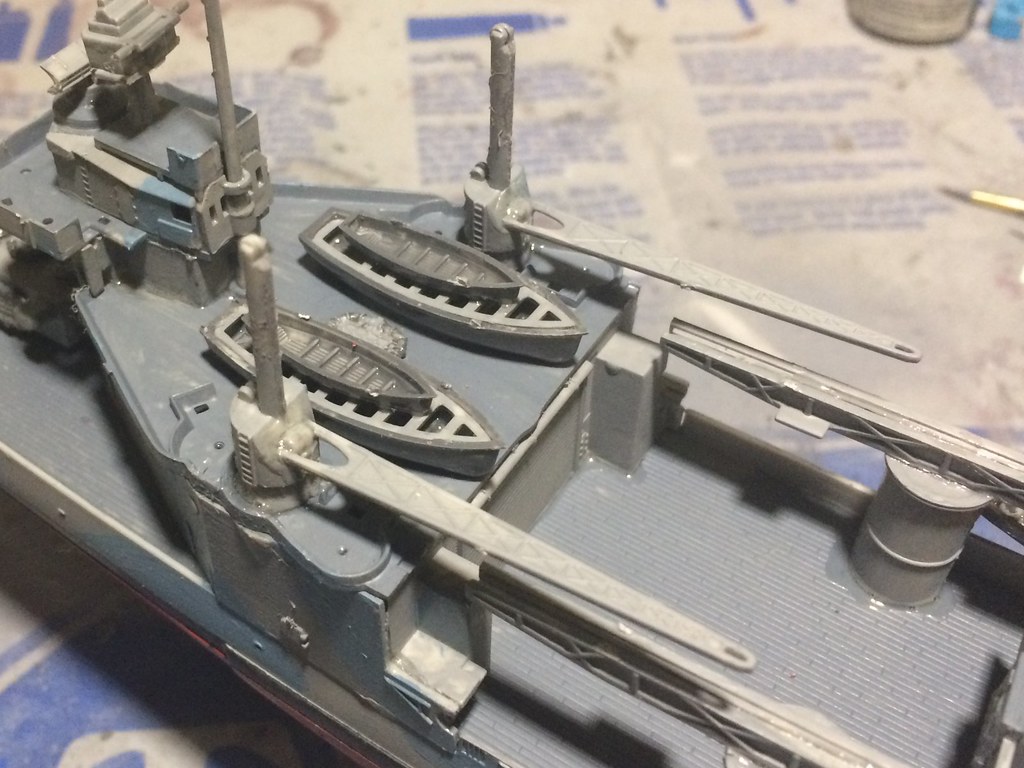
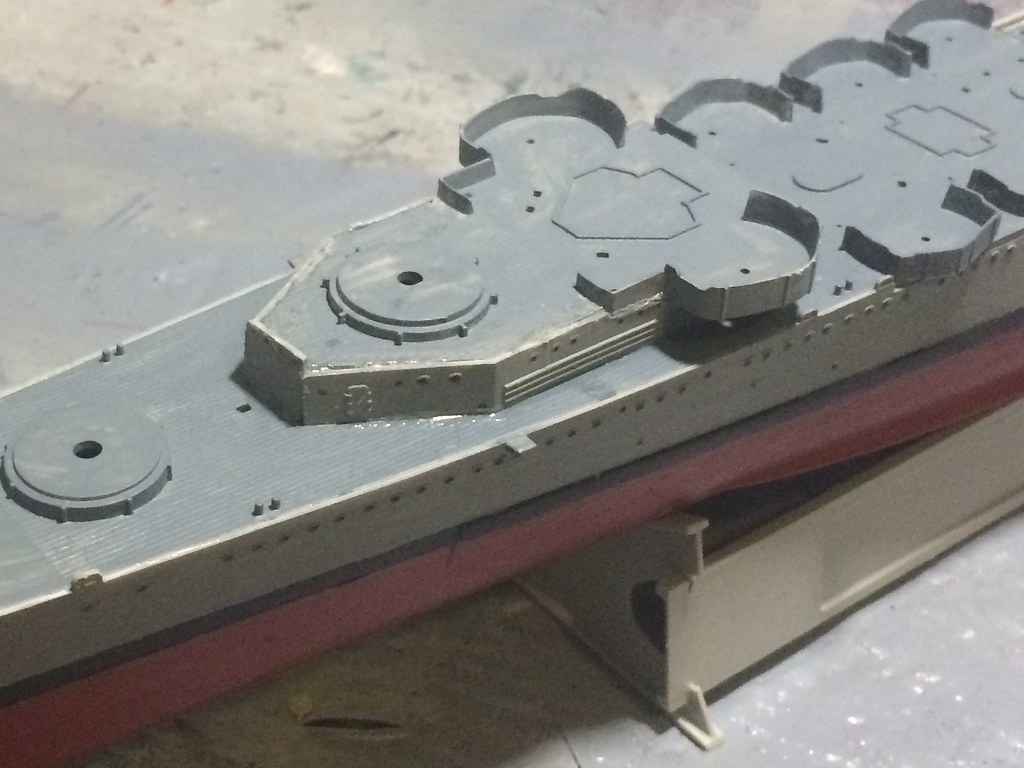
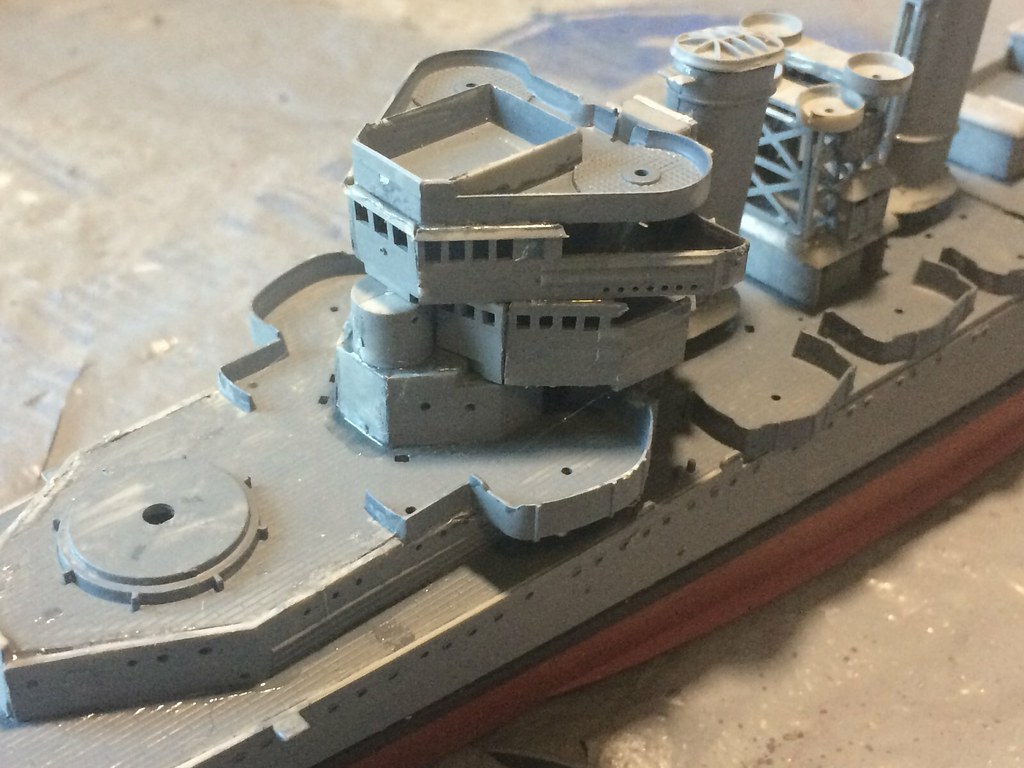
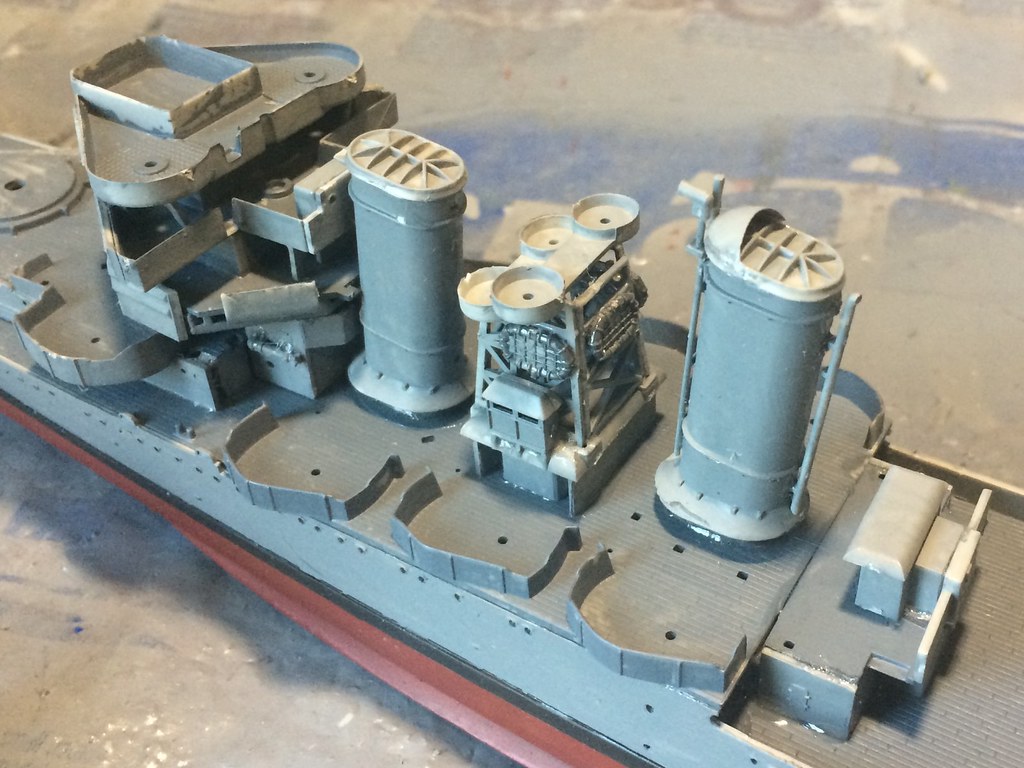

The Build - Nine inch main guns, five inch guns, 40mm cannons, 20 mm cannons and .50cal MGs - March 28, 2017
At this point I was ready to build the armament. This included the main guns which are three triple nine inch gun mounts. Each of these is a little model unto itself with the turret, the three guns, the range finders, and the lifer rafts mounted on the guns.
Then it was the eight single five inch gun mounts, the four times four forty millimeter, the fifteen 50 cal machine guns, each of which had its armor protection added, and the four double 20mm guns.
I also added the camo pattern to the verticale surfaces on the vessel...a blue gray.
Lots of guns...but they leave the ruiser fairly bristling with weaponry.

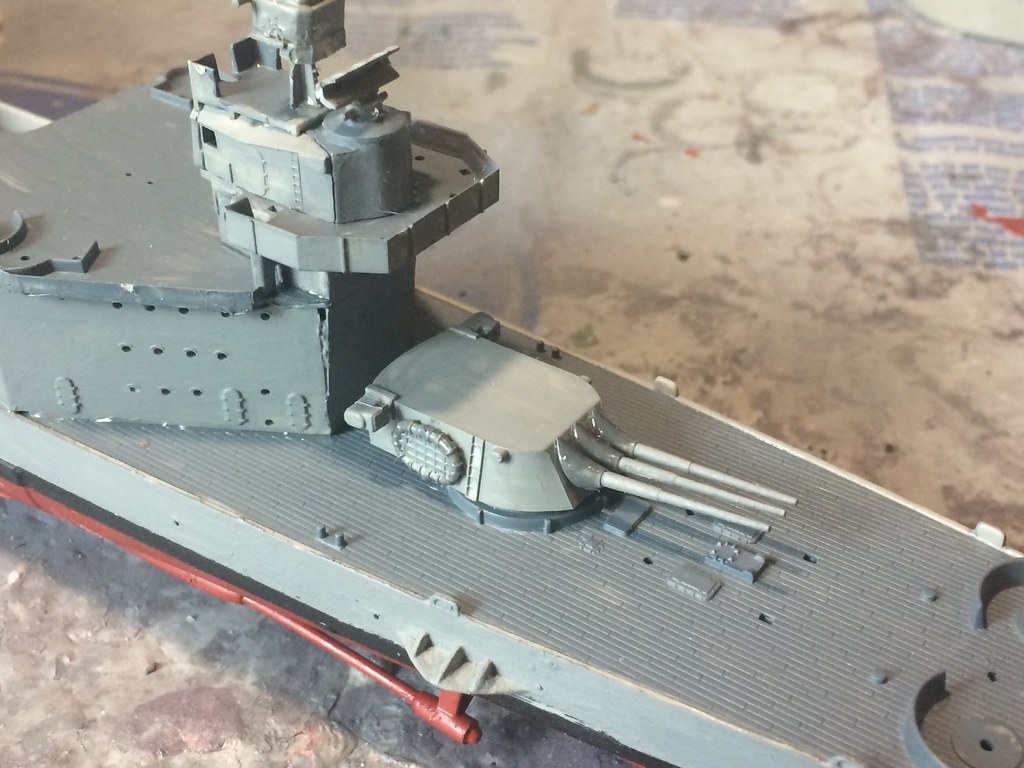
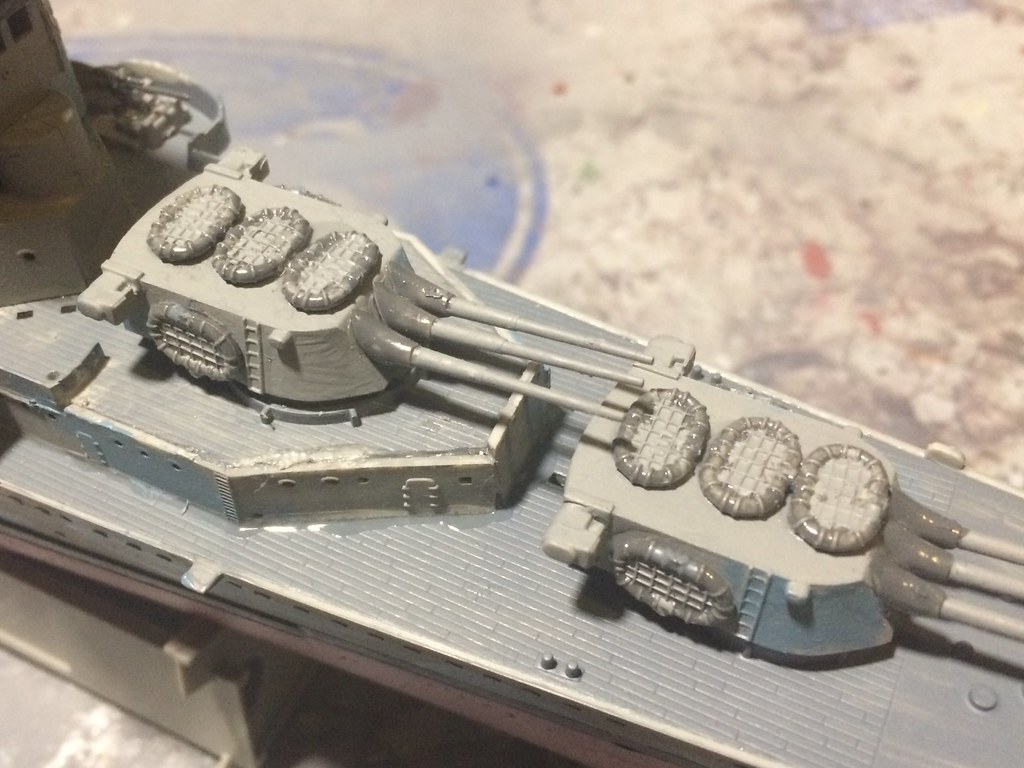
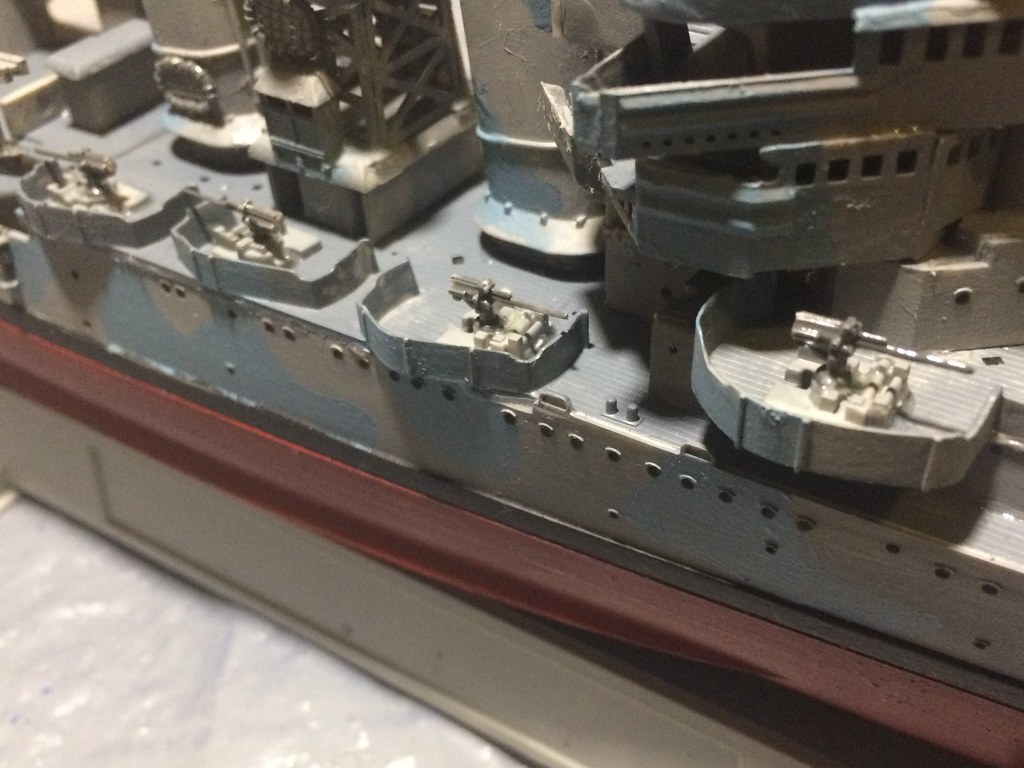
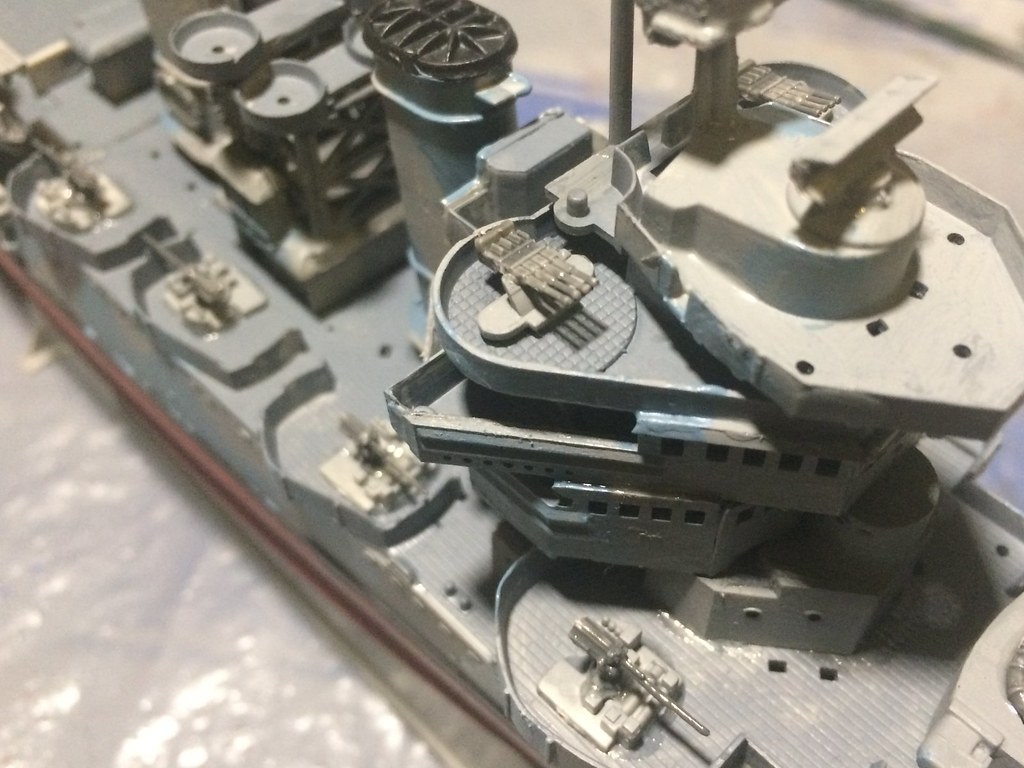
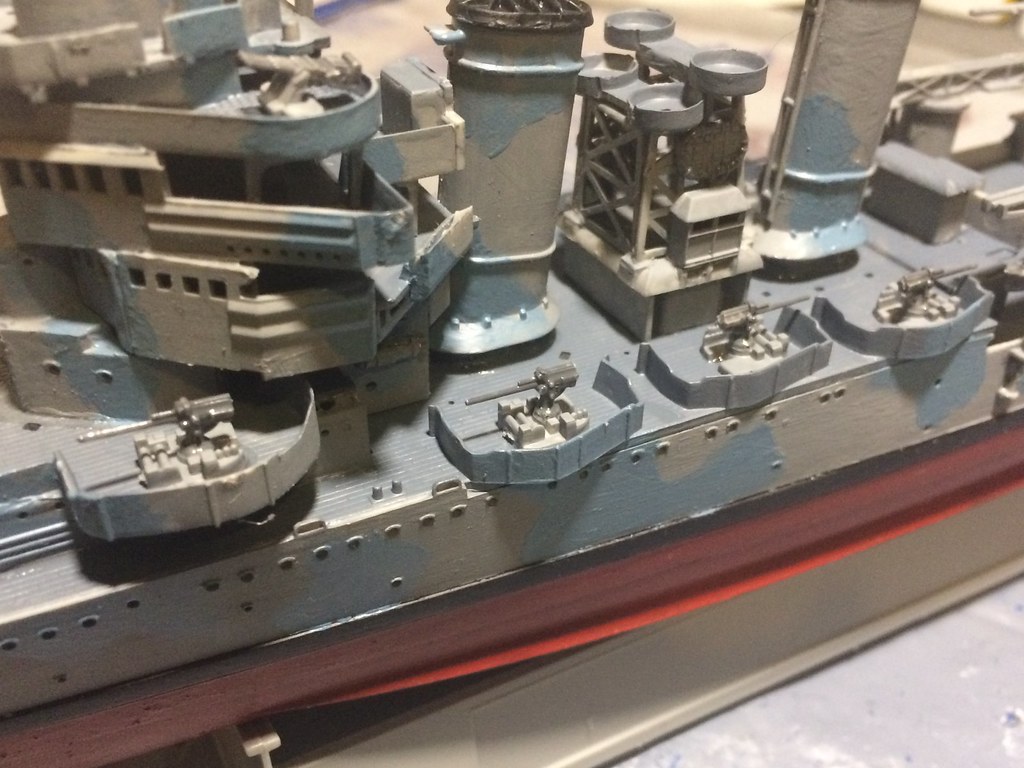
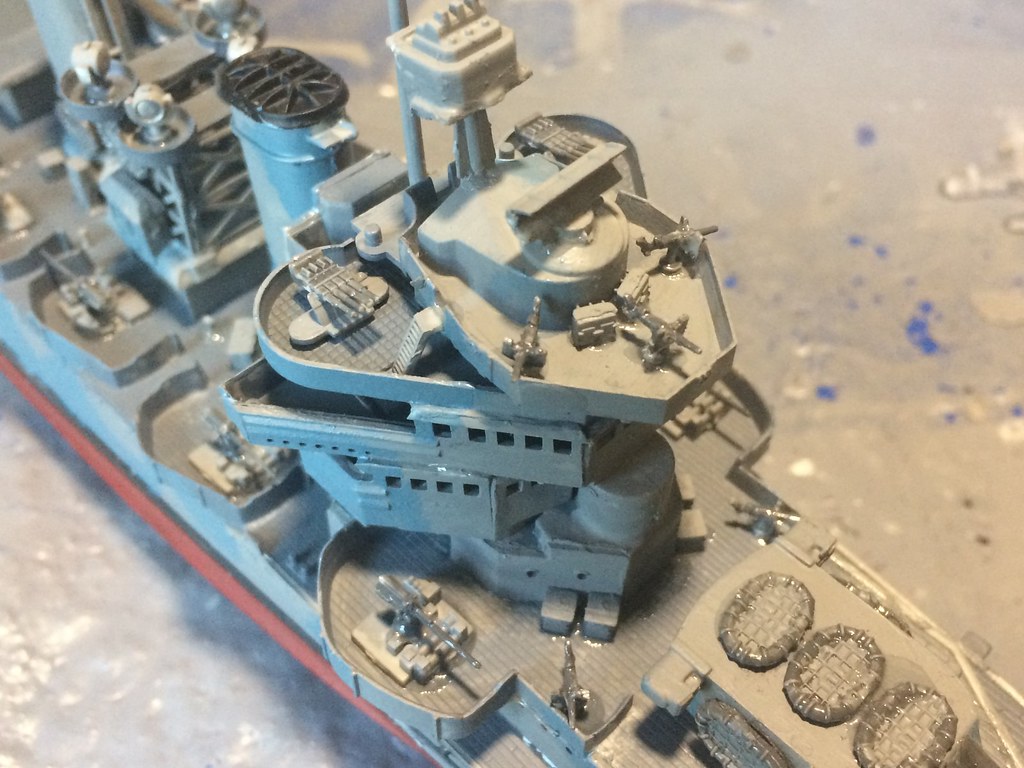
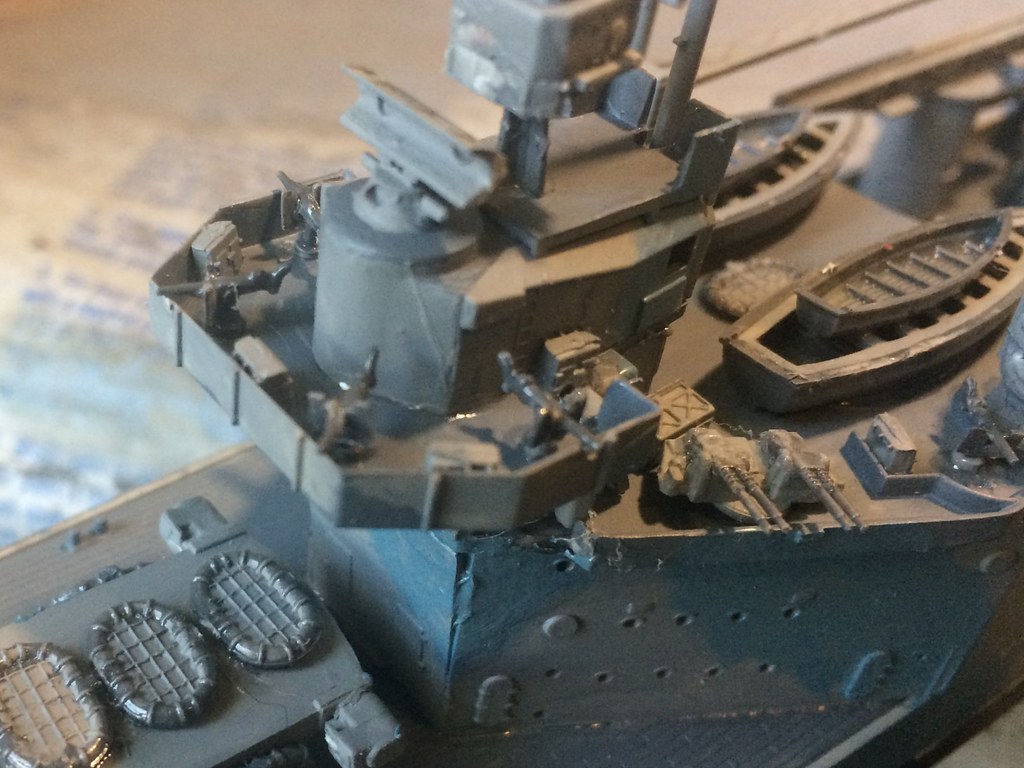
The ship is looking very nice at this point.
The Build - Details, instruments, life boats, ammo boxes, Depth Charges, aircraft, final deck details - April 1, 2017
At this point I added the myriad of details to the decks around the vessel. Ammo boxes, searchlights, instrumentation, depth charges, stairways, more life boats and davits. Also the catapults amidships, and the two masts.
This also included building the two search/scout aircraft.
This completed the vessel, but was time consuming because so many of these parts are very small and needed to be carefully attached:
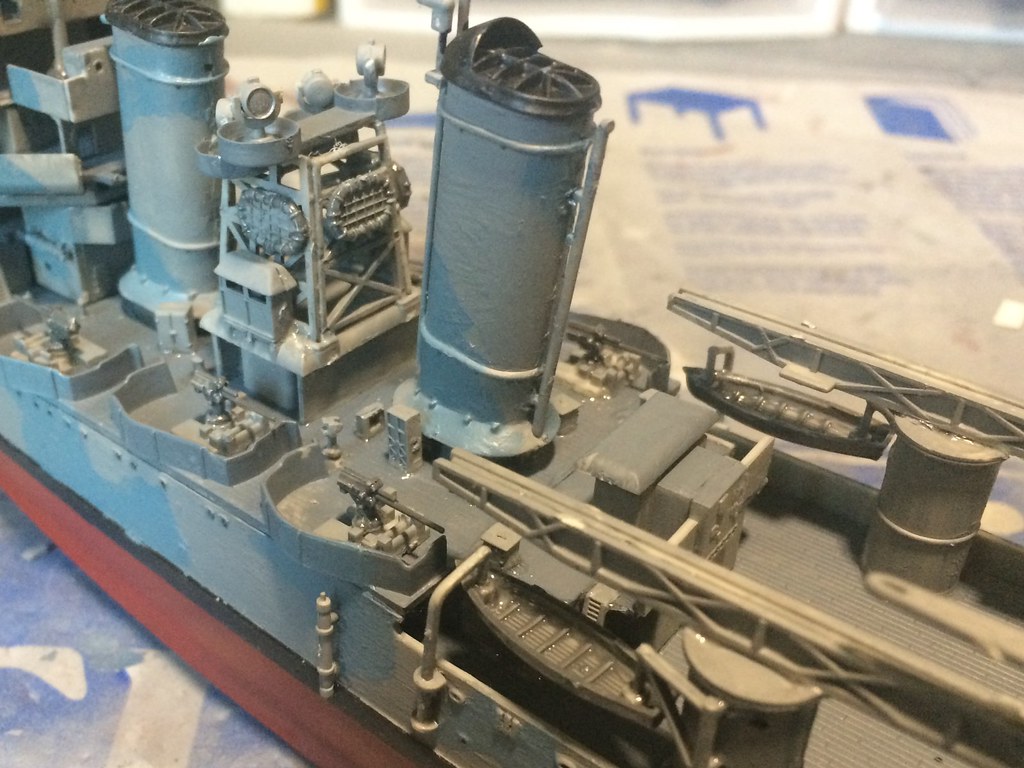
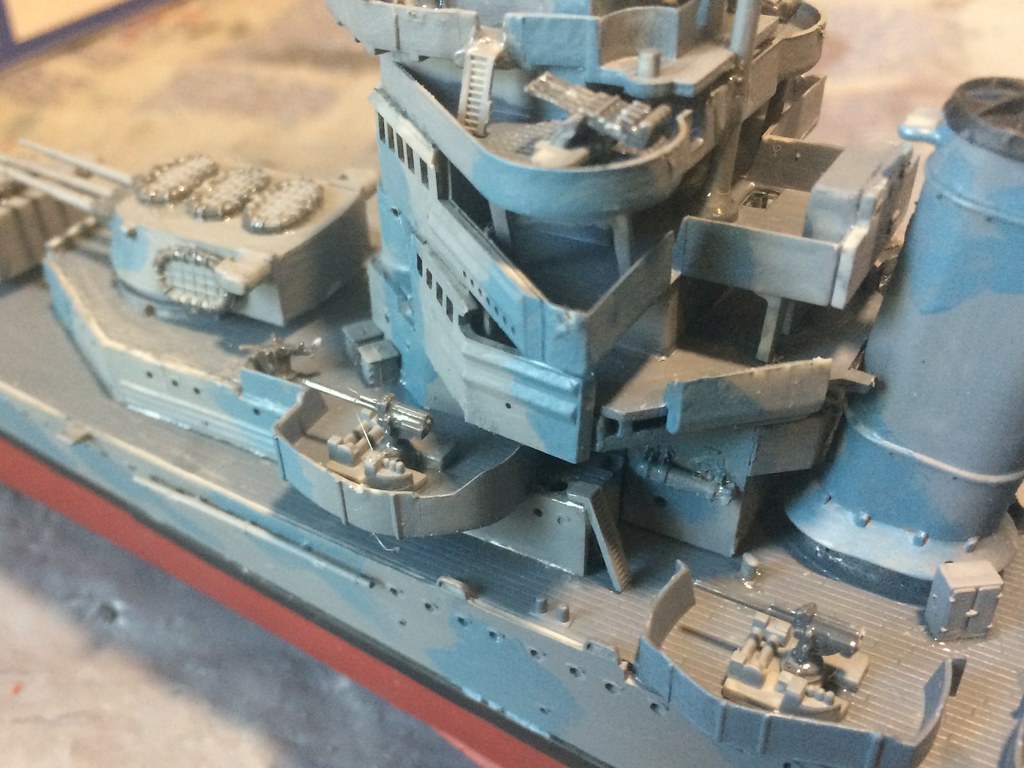
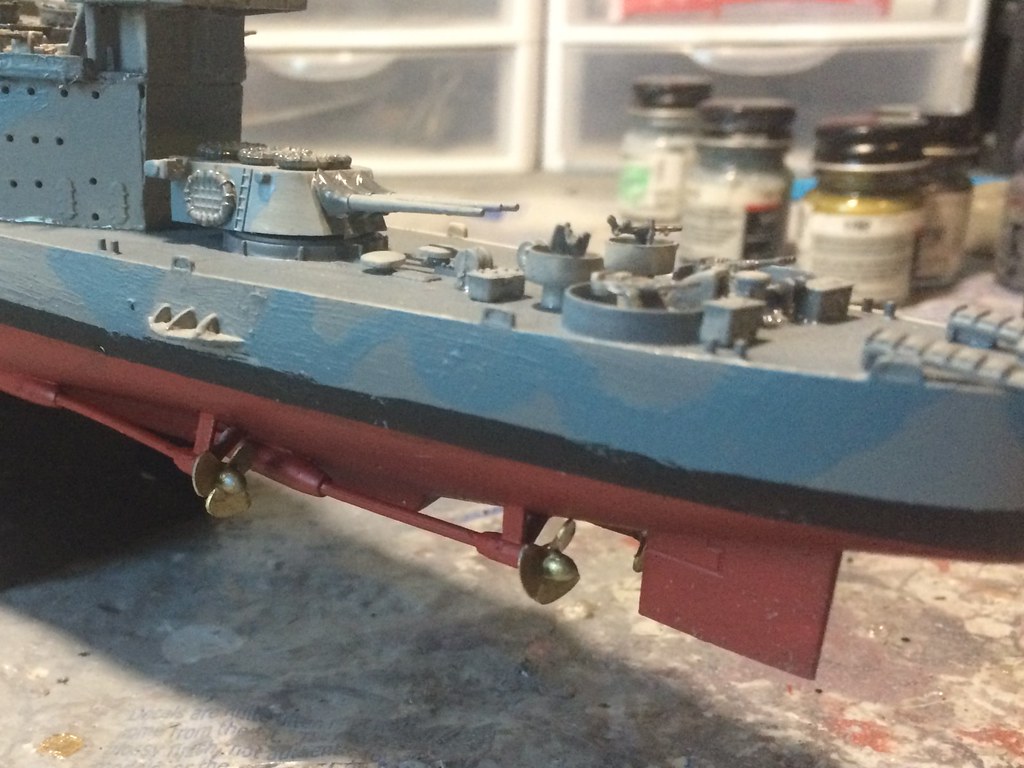
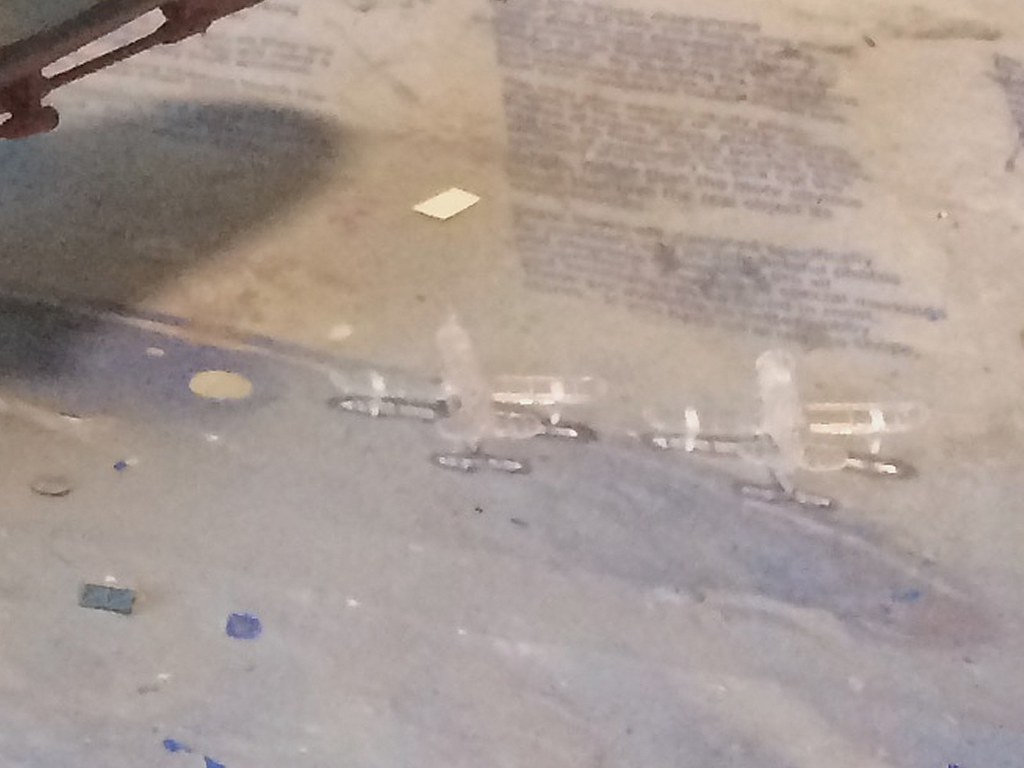
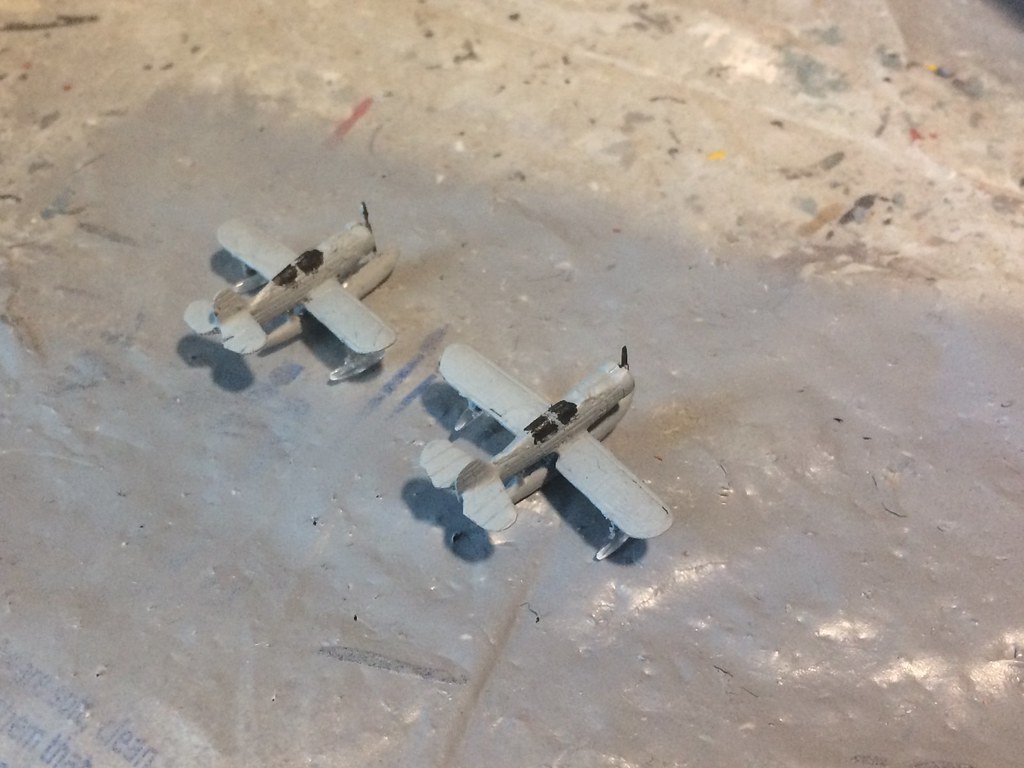
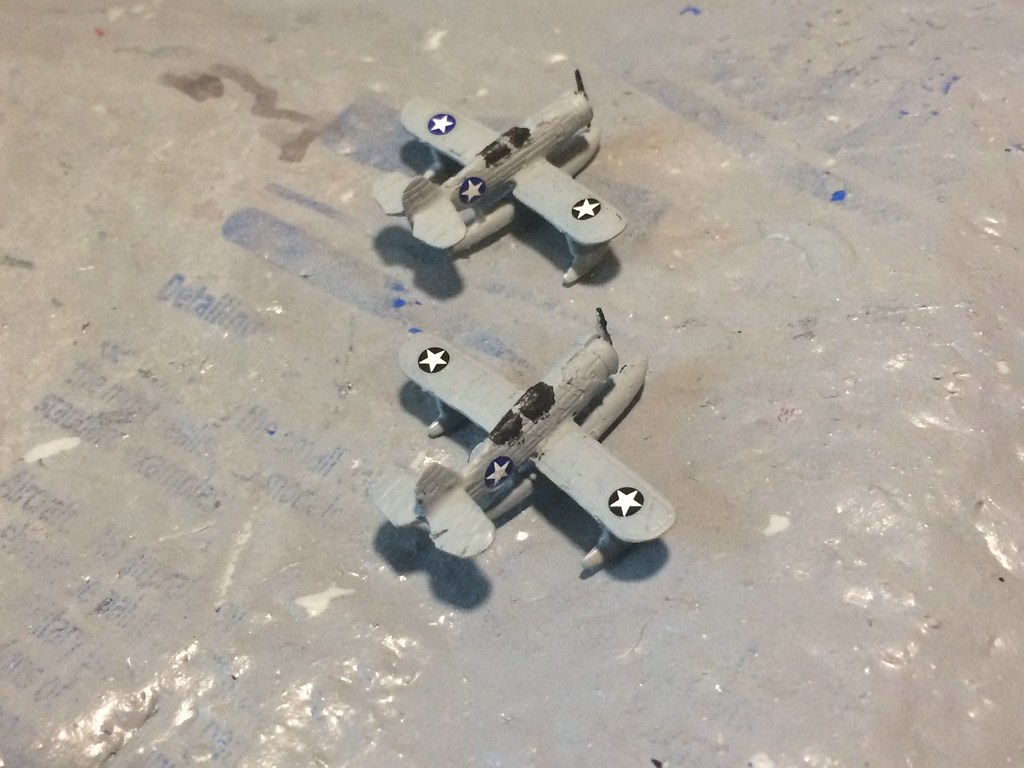
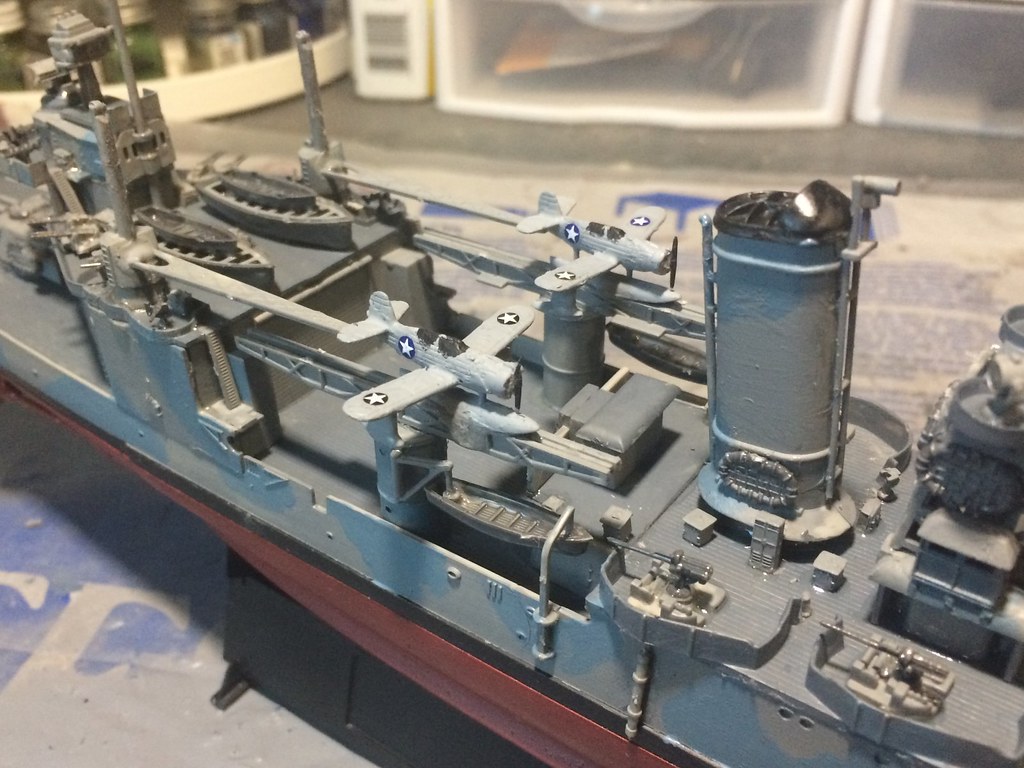
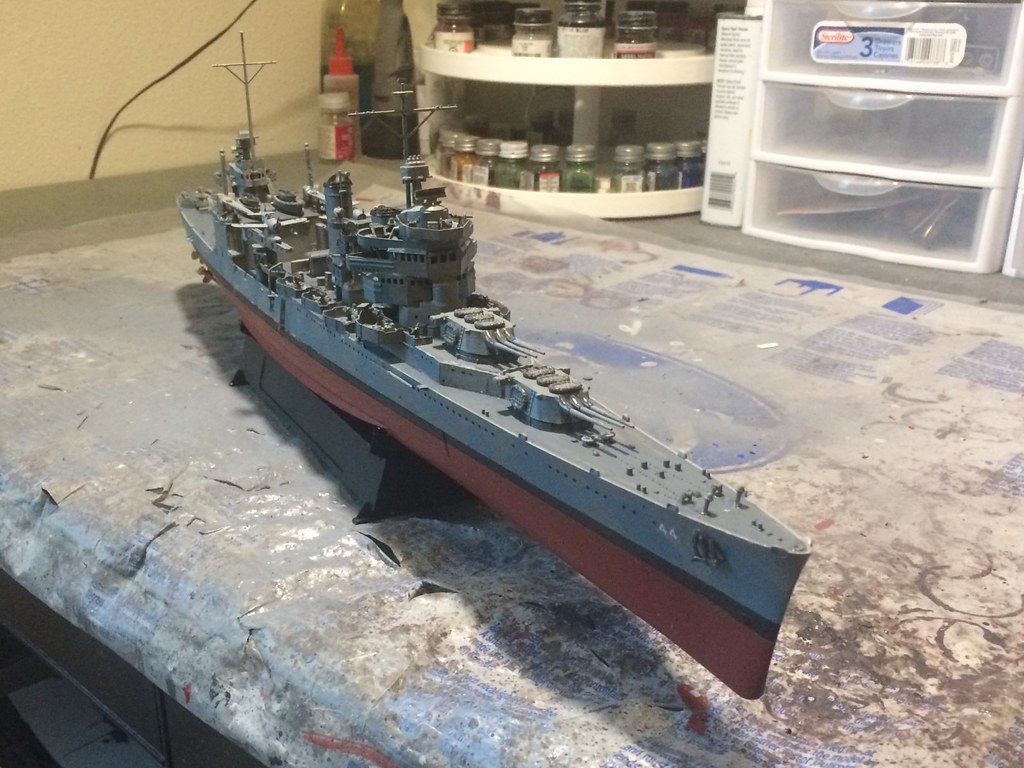
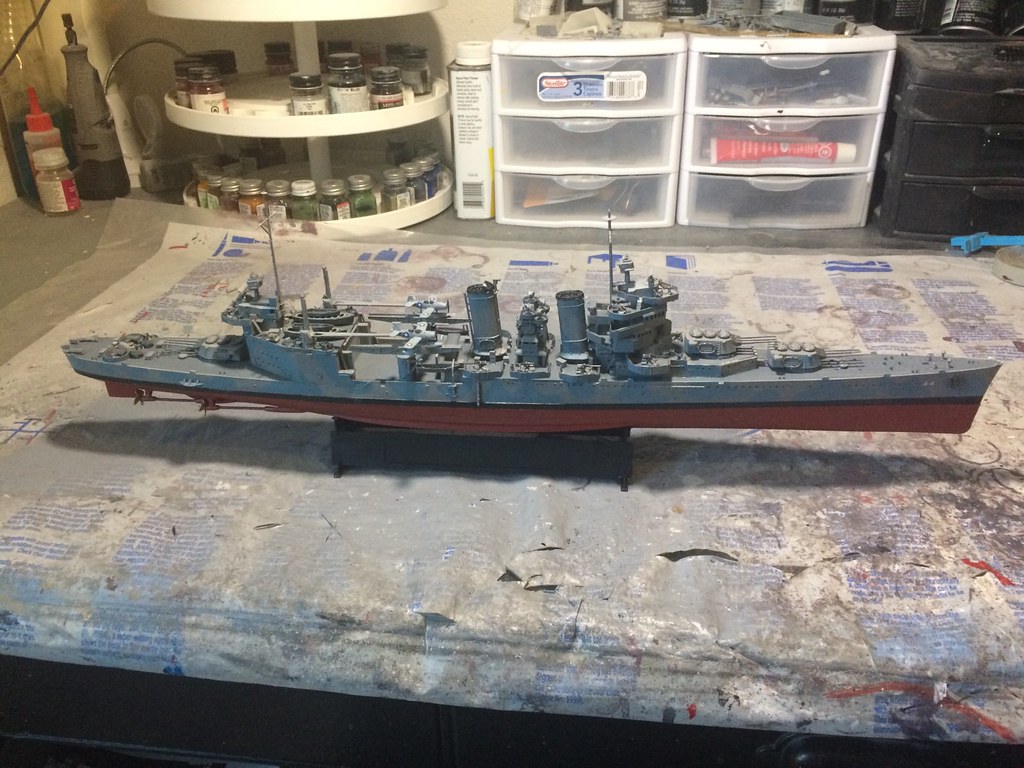
The Build - Final touch up paint, clear dull coat, and completing the model - April 4, 2017
At this point I went around the model and touched up some of the areas that needed final touch up paint as a result of the building that went on around them after they had been painted and installed.
I then added two coats of dull coat clear paint. This allows the finish that is more glossy from the glue to be rendered dull like the rest of the model so that it all blends in well together.
After this, the vessel was completed and ready to show off in its final pictures:

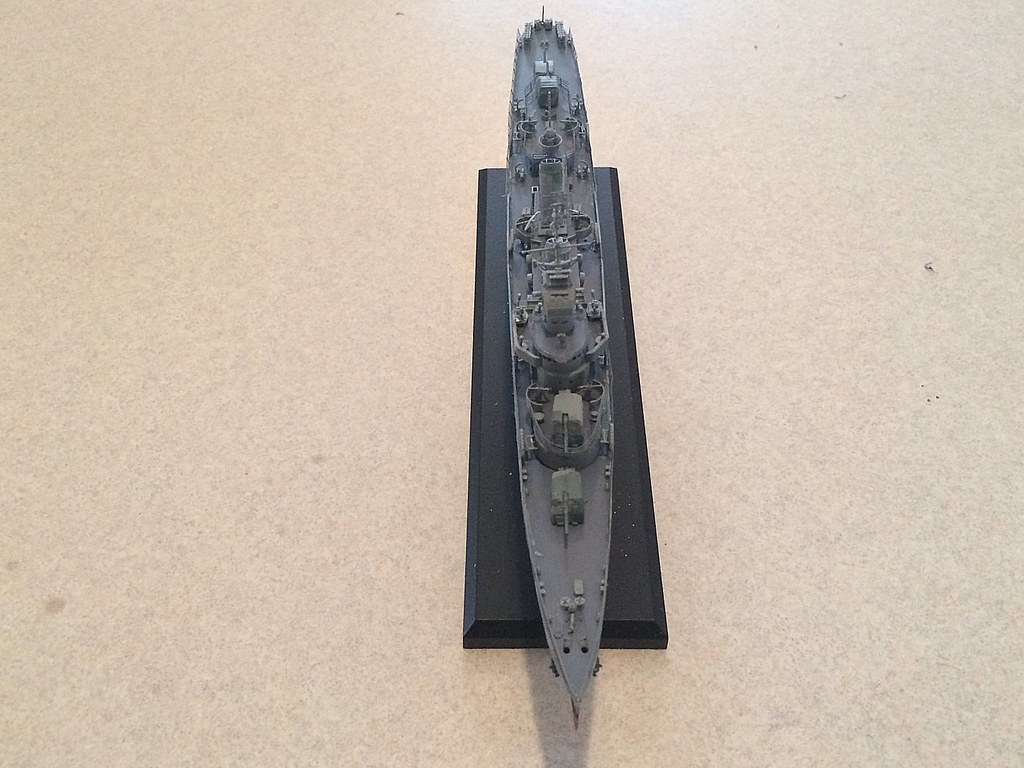
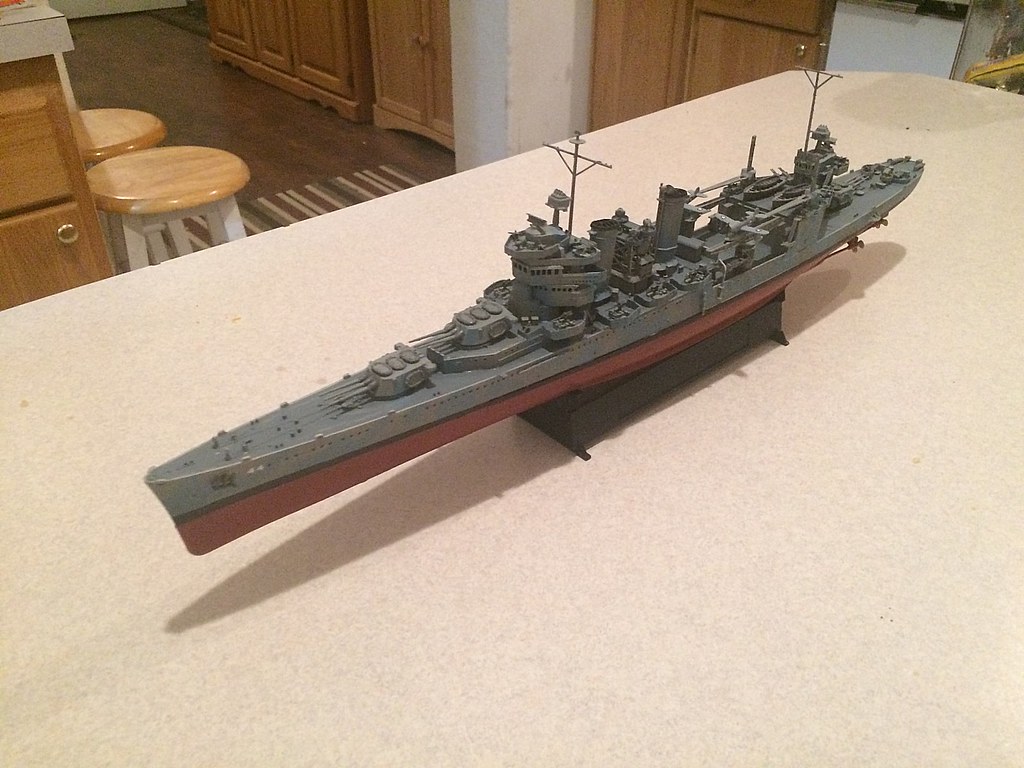
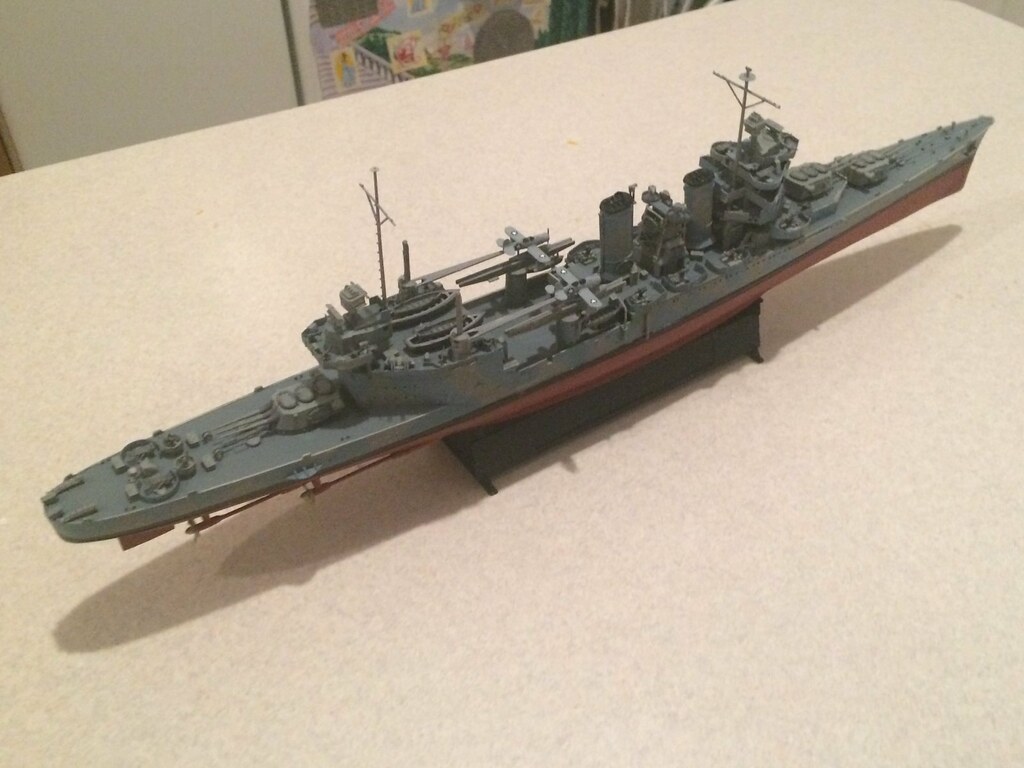
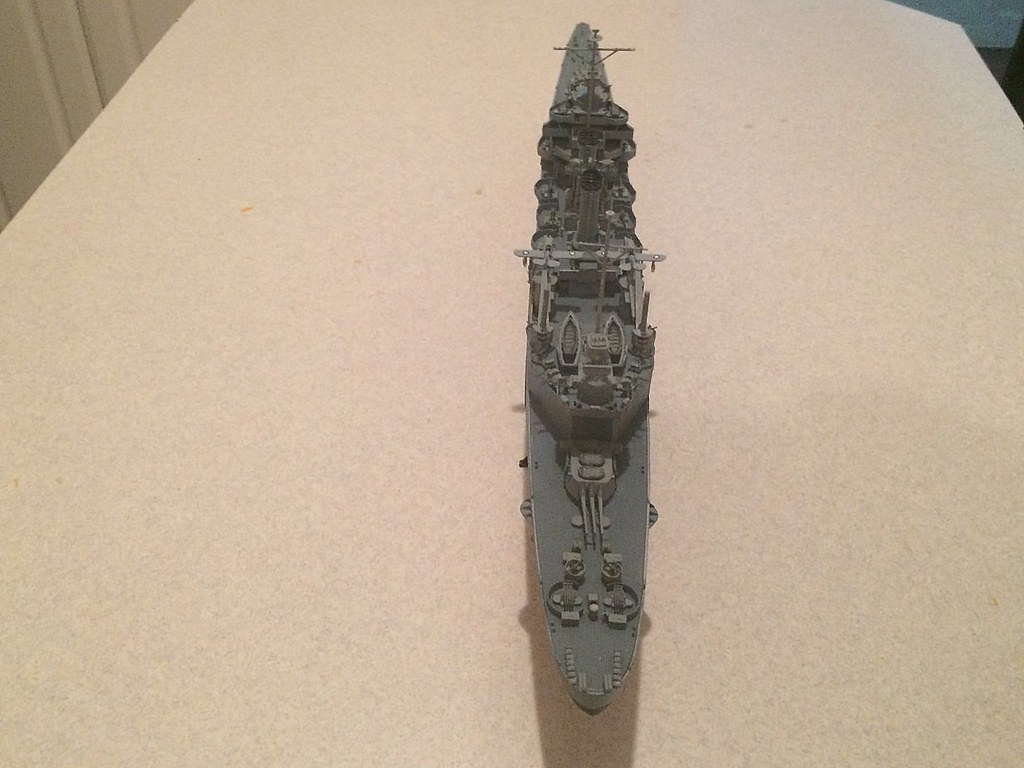
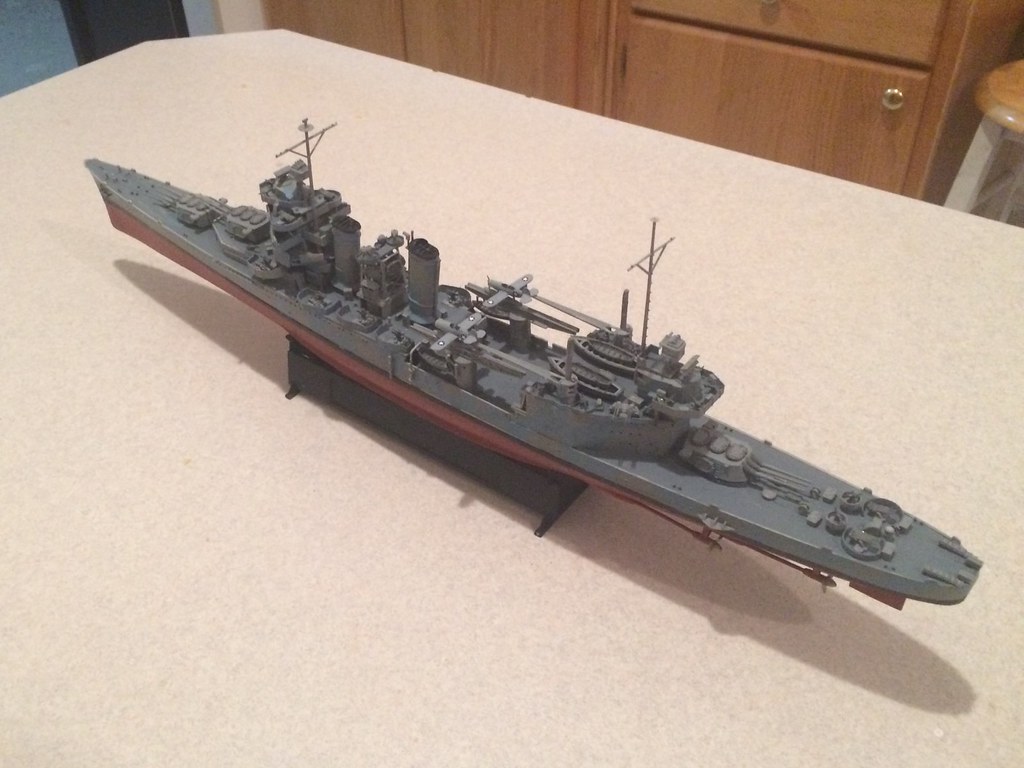
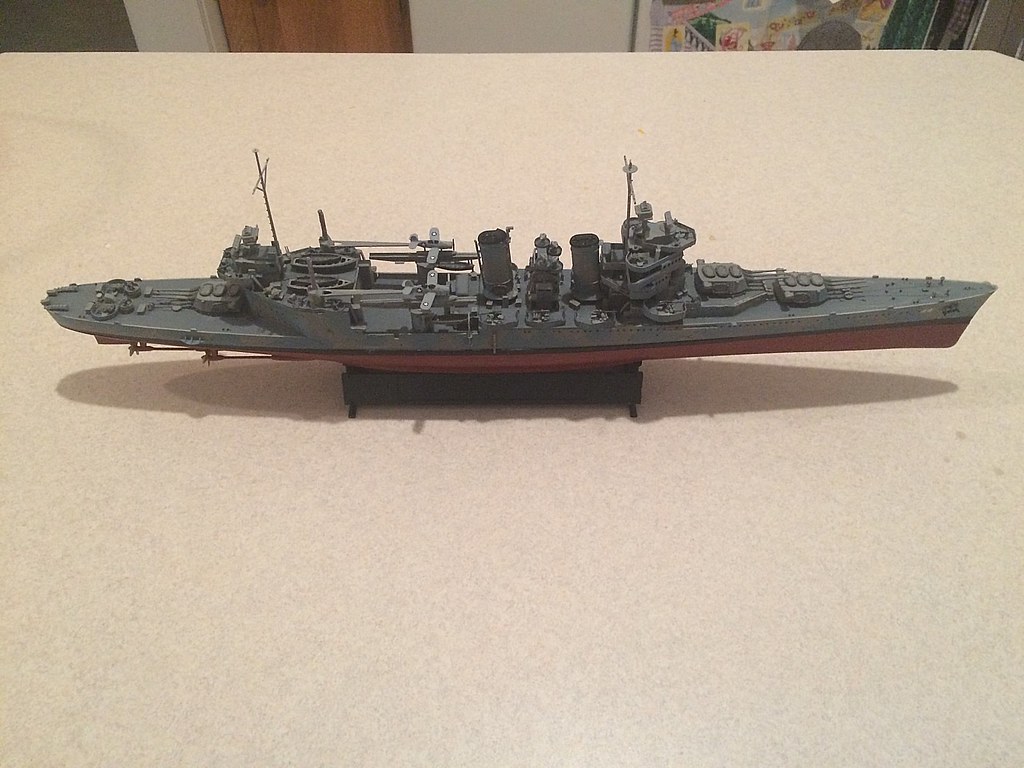
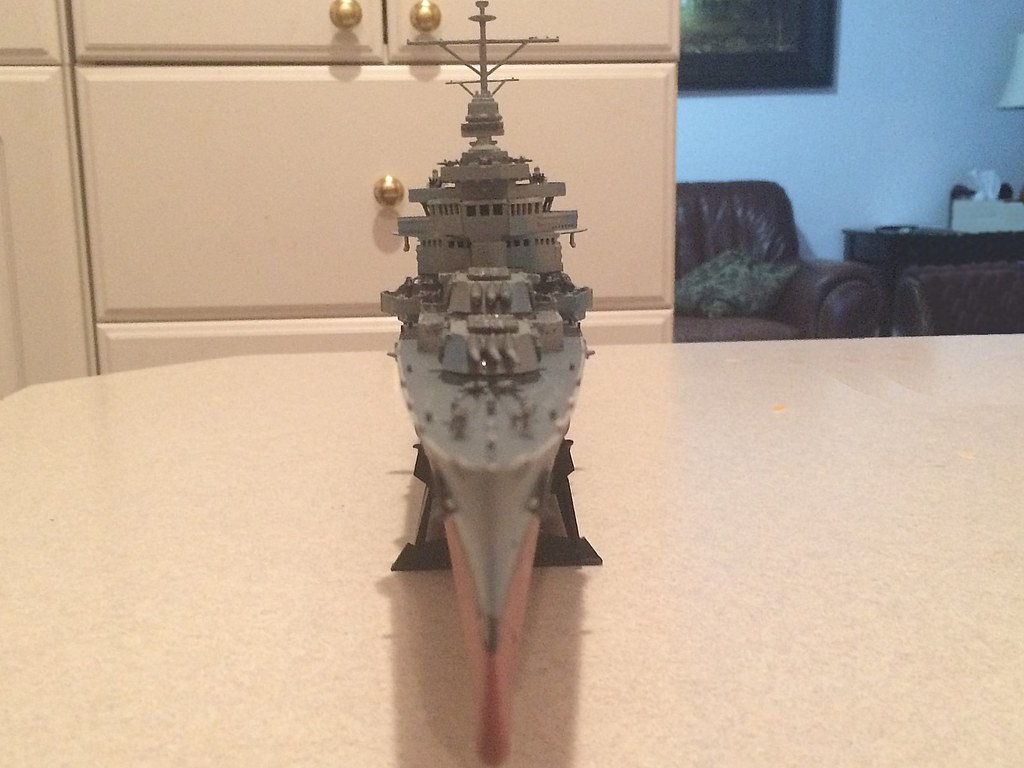
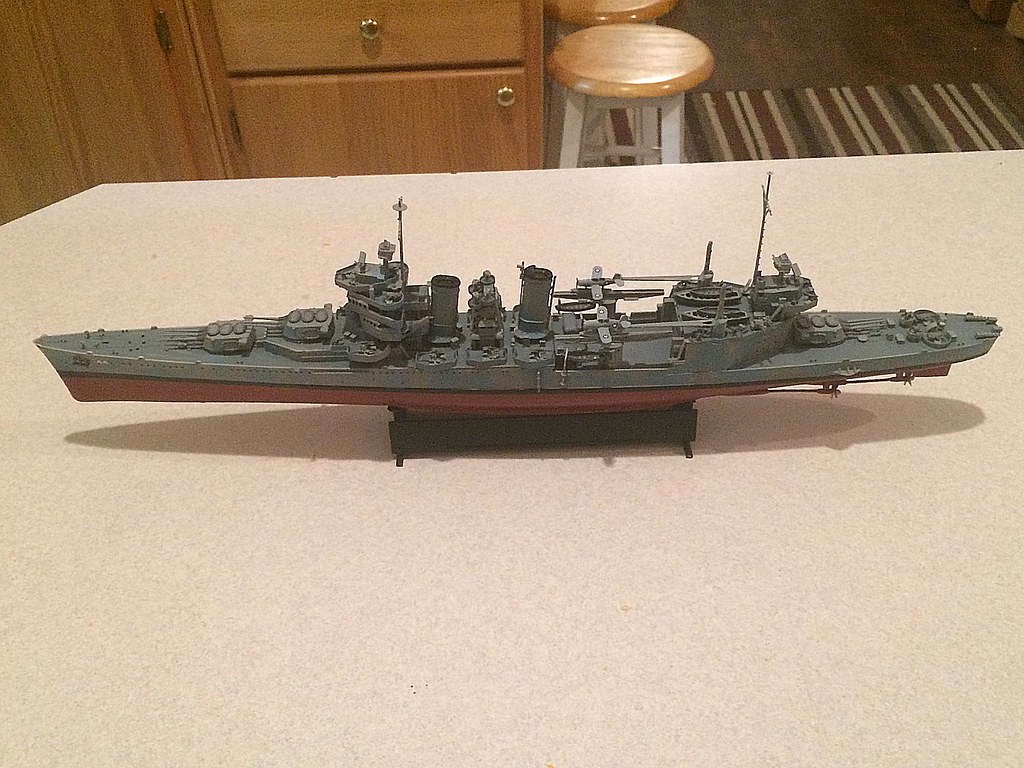
And some close ups:
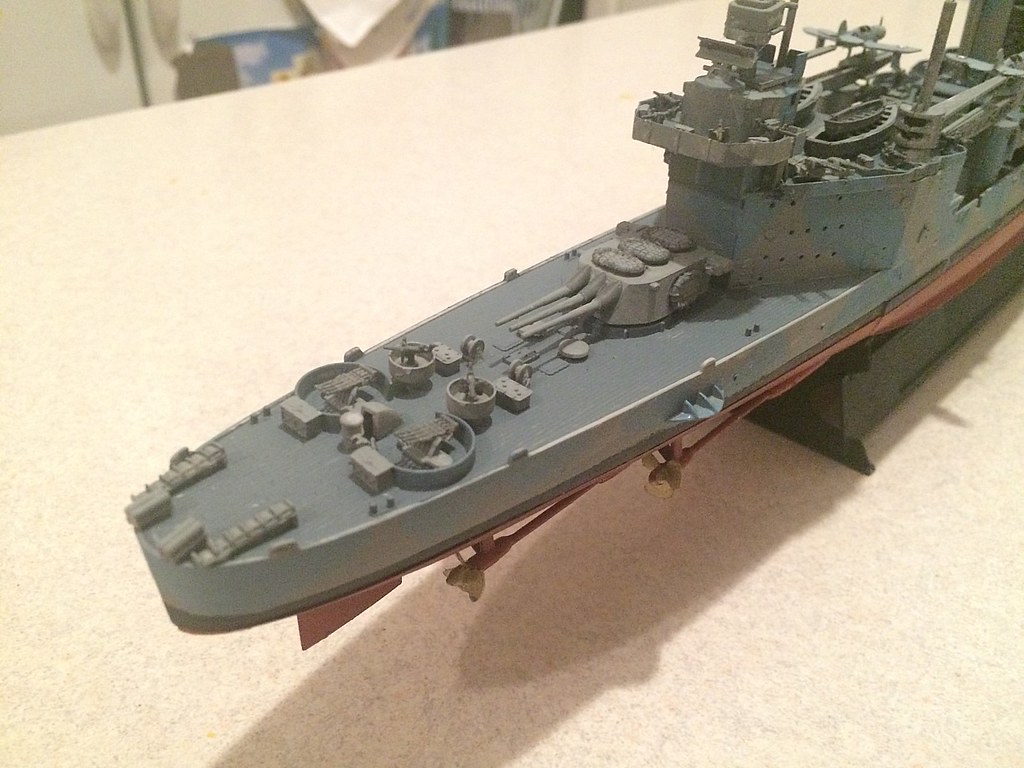
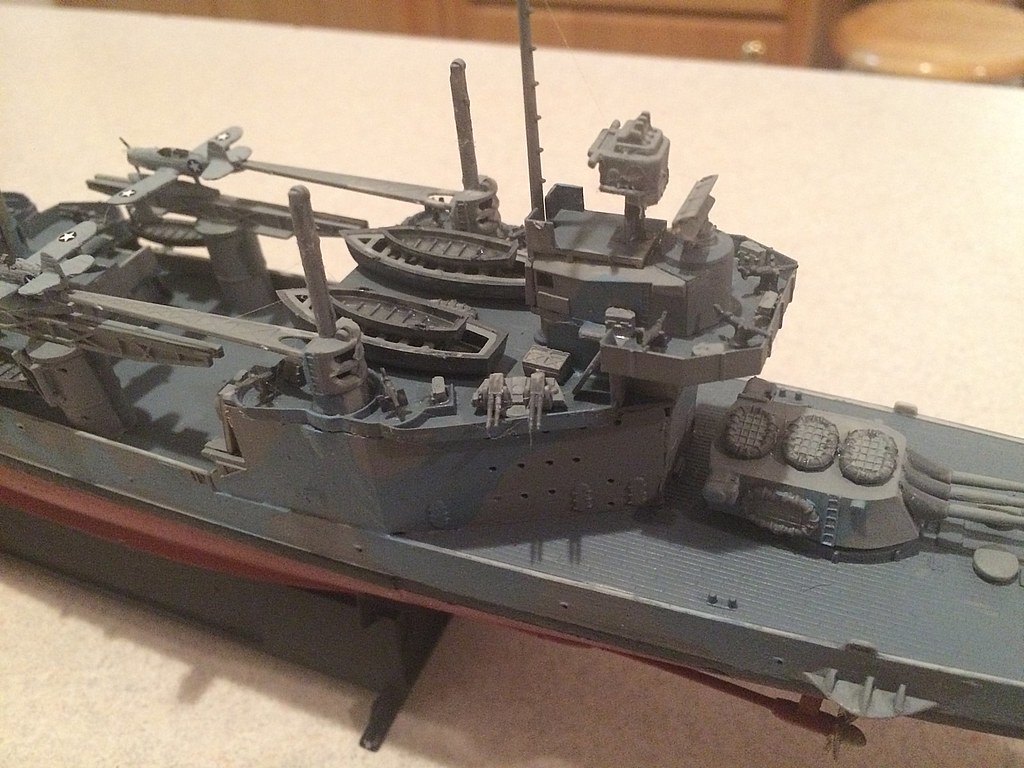
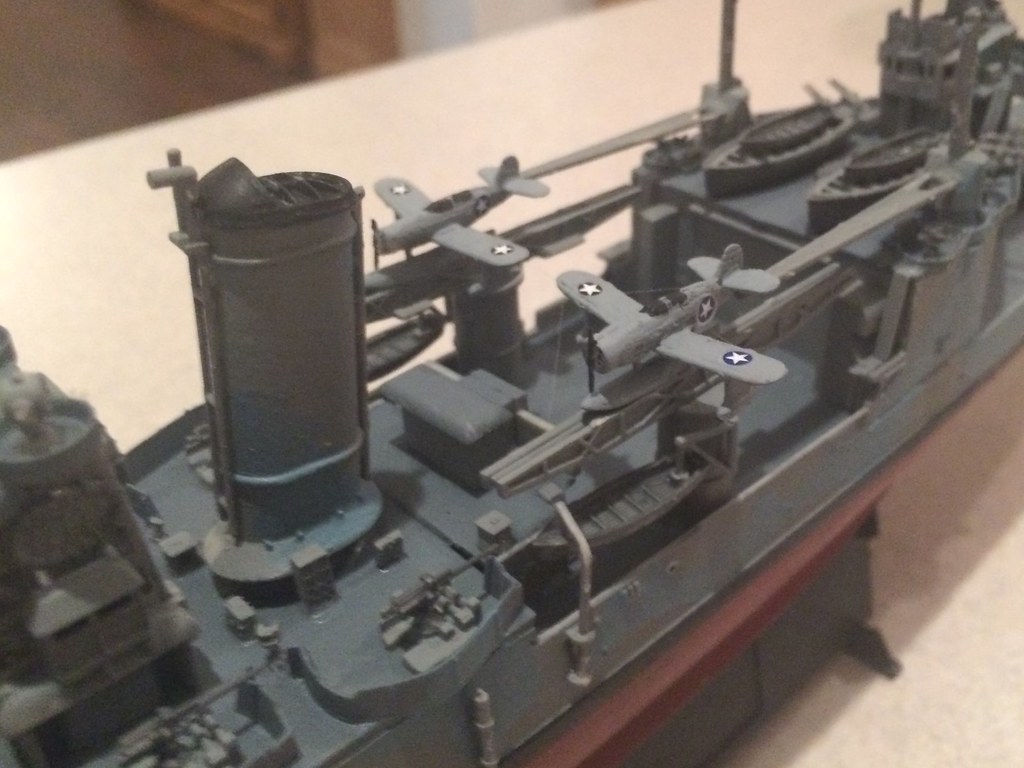
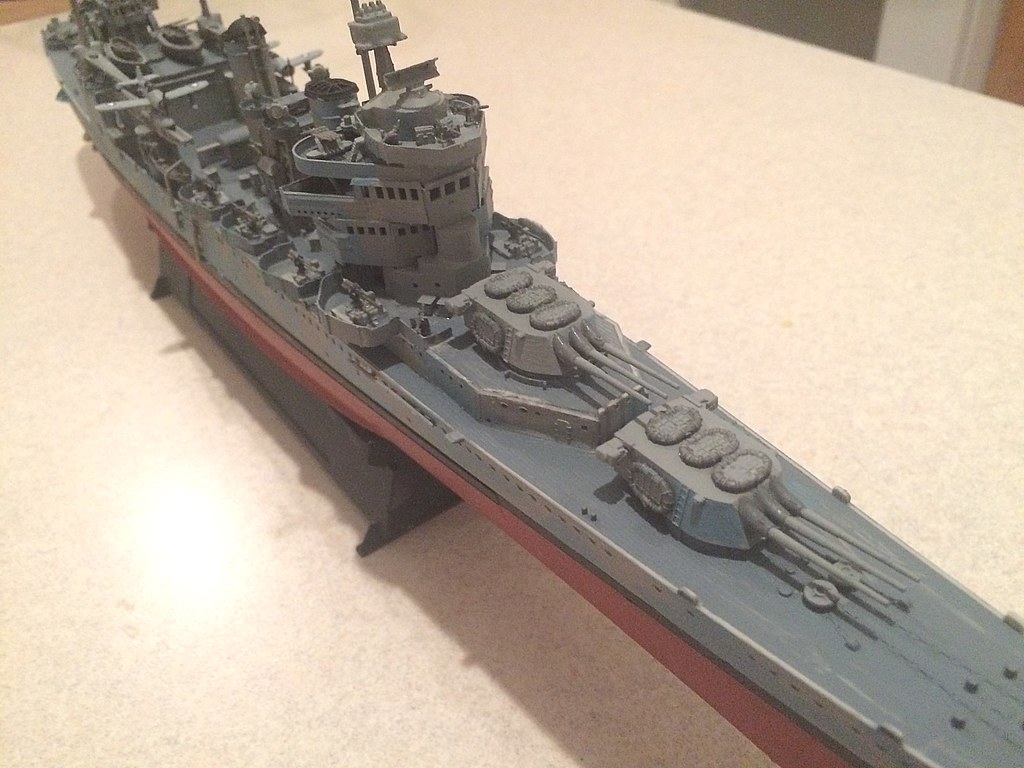
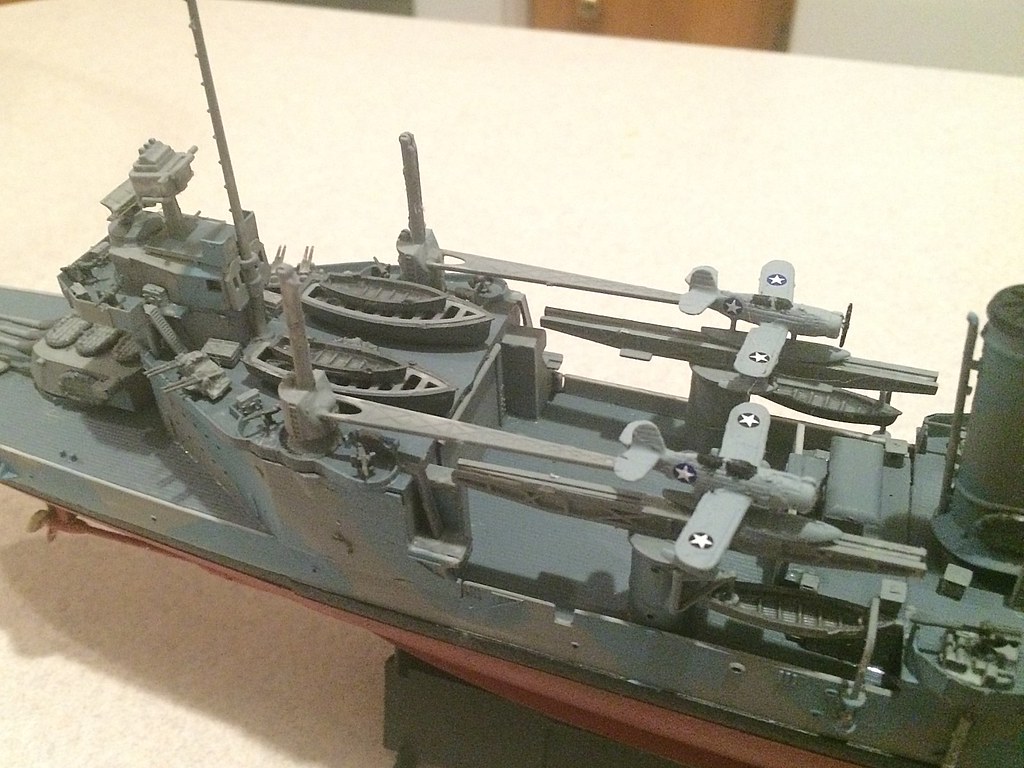
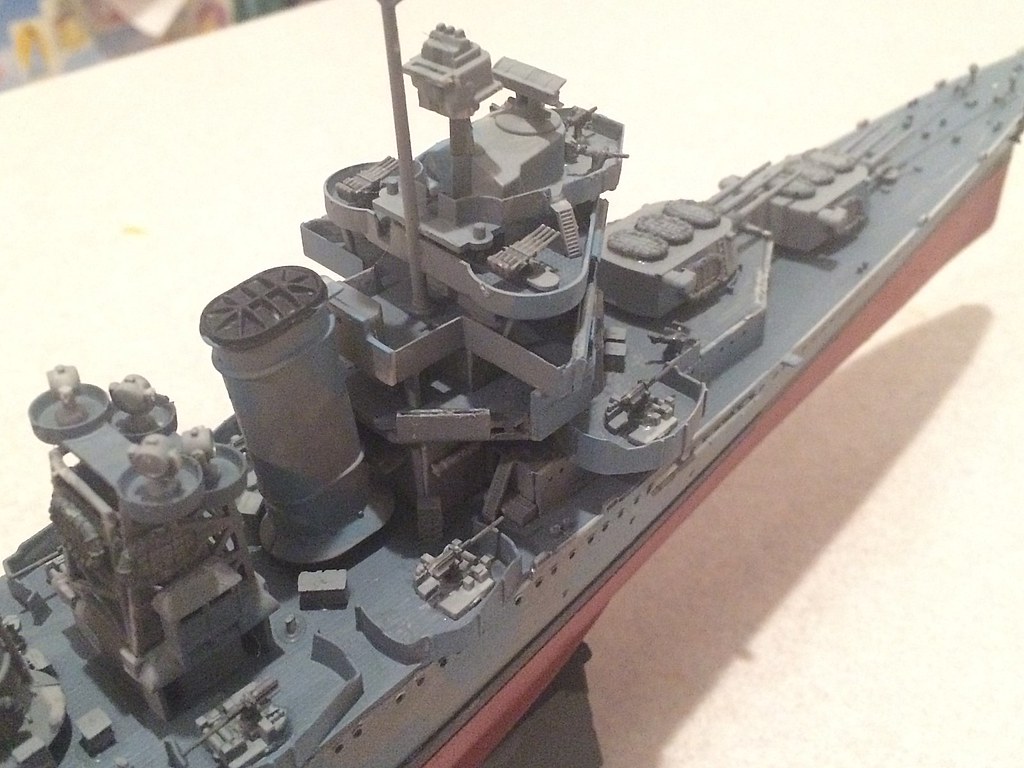
...and finally a couple of shots with the Vincennes, the Grayson, and the Hornet together:
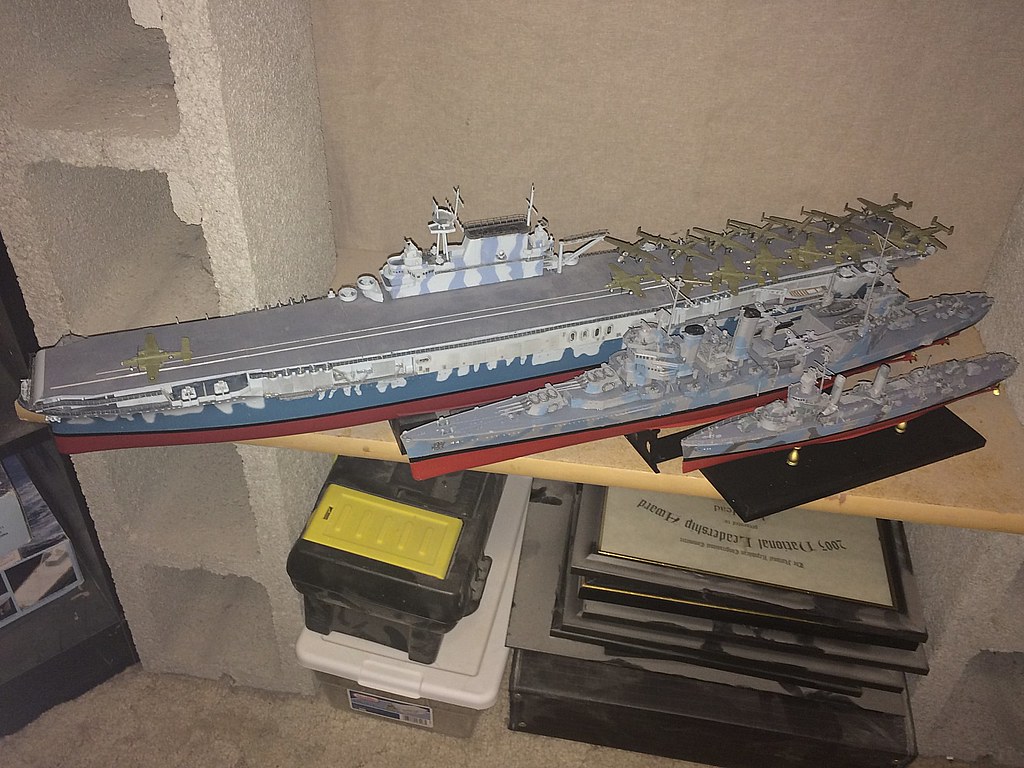
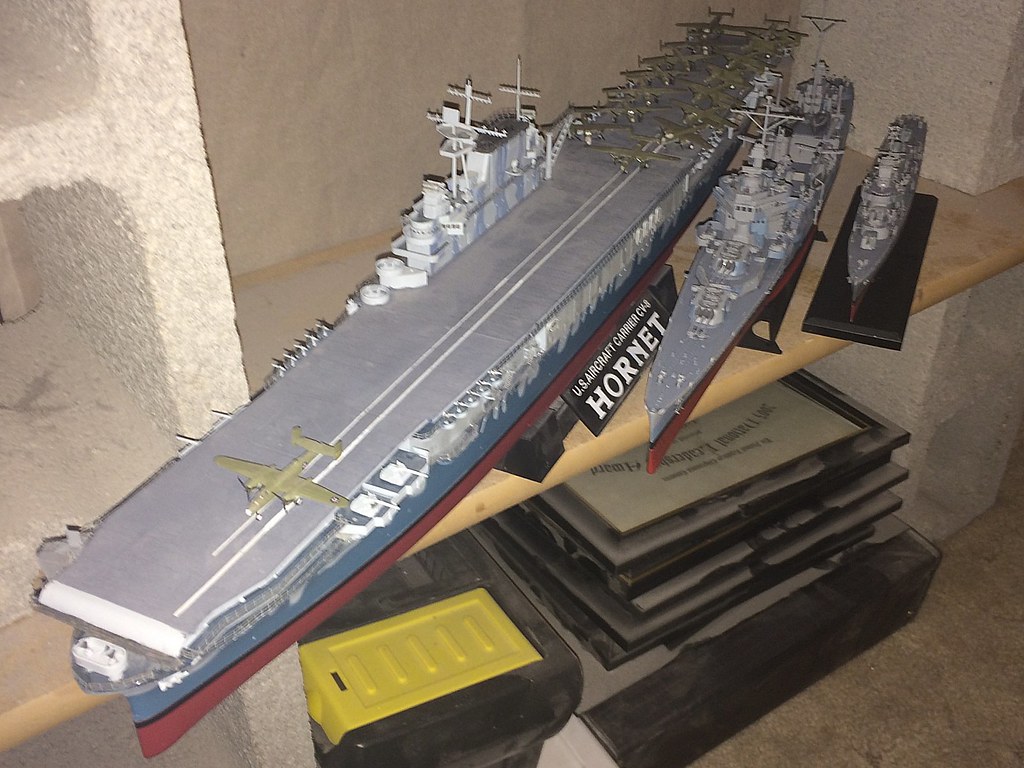
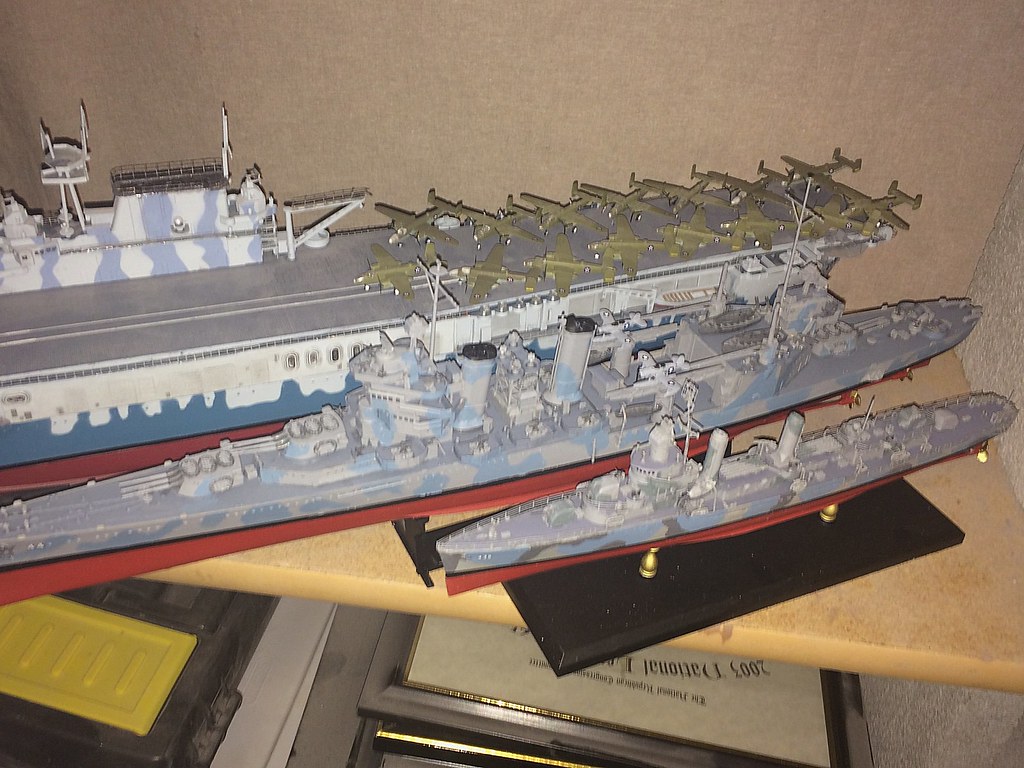
...and there you have the completed USS Vincennes, CA-45, that was a part of the Doolittle Task Force.
- By June 1st, 2017 complete the WW II USS Enterprise, CV-6, in 1/350 scale
My Modern aircraft carrier groups:
The completion of the PLAN Carrier group was centered on the already completed Trumpeter's 1/350 scale PLA Navy's Aircraft Carrier CV-16, Liaoning, (in addition to the other escorts already completed) included Mini Hobby's PLAN Guangzhou, DDG-168. I recently pre-ordered a 1/350 scale model of the PLAN Type 071 LPD, Yuzhao Class, announced by Dragon and due out in October, 2013. I will end up adding two of those, probably LPD-998 Yuzhao and LPD-999, Jinggangshan, add the PLAN- DDG-139, Ningbo, and the PLAN DDG-115, Shenyang, along with the PLAN Weifang, FFG-550 and thus build a PLAN ARG.
The completion of the US Carrier Strike group was centered on the completed Tamyia's 1/350 scale USS Enterprise, CVN-65, (in addition to the other escorts already completed) included Dragon's, USS Freedom, LCS-1, Dragon's USS Preble, DDG-88 and Hobby Boss's USS Texas, SSN-775. When a 1/350 scale USS Enterprise, CVN-80 (or any Gerald R. Ford Class) is released from Dragon, Tamiya, Dragon, or whomever else, I will add it to this group along with another AEGIS Cruiser. Whichever Ford Class coms out in 1/350 scale, I will build it as the USS Enterprise, CVN-80.
The US ARG includes Tamiya's 1/350 scale, USS Iowa, BB-62 (which I have already completed), Gallery's 1/350 scale USS Iwo Jima LHD-7, Gallery's 1/350 scale (already completed), USS New York, LPD-21 (Completed), Cyber Hobby's USS Independence, LCS-2 (Completed), Bronco Model's 1/350 scale USS Coronado, LCS-4 (Completed), a Flight IIA US AEGIS class Heavy Cruiser based on Dragon's 1/350 scale USS The Sullivans, DDG-68 (Completed), a Ticonderoga AEGIS cruiser (Completed), and a 1/350 scale Orange Hobbies USS Harper's Ferry, LSD-49...all of these models which I already own.
The completion of the UK Group featured the Airfix 1/350 scale HMS Illustrious, R06 as its center piece until a 1/350 scale Queen Elizabeth carrier is released. When that happens, I will add that carrier to the group as its centerpiece. The Royal Navy CSG will also include two Airfix 1/350 scale Daring Class DDGs (one of which is already completed), two Dragon 1/350 scale Type 23 HMS Duke class Frigates (one of which is already completed), and the Hobby Boss 1/350 scale HMS Astute SSN (which is also already completed) and Airfix 1/350 scale HMS Trafalgar SSN. One day, when a 1/350 scale HMS Ocean LPD comes out, I will use it to start building a Royal Navy ARG.
The French CSG is centered on Heller's 1/400 scale Charles De Gaulle, R91. I have purchased the 1/400 scale Heller French De Grasse, D612 DDG, which is an ASW DDG, the French Duquesne, D603 DDG which is an anti-air multi-purpose DDG, and the French Aconit D612 FFG and Gueprattet F714 FFGs, both of which are Lafayette class frigates. These five vessels round out my French CSG and are all completed. As soon as a French Robin class nuclear sub, like the French Pearle S606 SSN is released in 1/350 or 1/400 scale, I will add that to the group. Also as soon as the Forbin D620, Horizon class anti-air DDG is released in 1/350 or 1/400 scale, I will purchase two of them and replace the De Grasse and Duquesne with them, and then save those two for when a Mistral Class LPD is released in 1/350 or 1/400 scale so I can create a French ARG with those vessels.
The completion of the Japanese JMSDF group was centered on Fujimi's very finely detailed, 1/350 scale Hyuga, DDH-181. It will be escorted by Dragon's 1/350 scale DDG-177, Atago, an AEGIS class DDG and the JMSDF, DDG-174, Kongo class (which I own), Dragon’s 1/350 scale DDG-114 Susunami and DDG-111 (both of which are Takinami Class DDGs which I own), and by the 1/350 scale SS-503 Hakuryu (which I own), one of Japans new, very modern and capable AIP Diesel Electric submarines. It also included a Arts Technic 1/350 scale, DDG-116 Teruzuki (Akizuki class) Heavy Cruiser. Should a 1/350 scale Osumi Class LPD and/or the larger 1/350 Izumo class DDH be released, I will buy those vessels and add them to the group.
Then, finally the Russian CSG (centered on Trumpeter's Kuznetsov which I own) the Russian Kirov Class nuclear battle cruiser (CGN), the Peter the Great, by Trumpeter, the Russian Slava Class cruiser, Varyag by Dragon (which I own), two Dragon 1/350 scale Udaloy DDGs (which I own), Hobby Boss's Akula II class SSN (which I own), and the new Yasen class Russian SSN (which I own), all in 1/350 scale. These are all completed as well. Sometime in the more distant future when a 1/350 scale Russian version of the French Mistral class comes out (which is building in real life right now), I will add two of those and build a Russian ARG.
Recently I purchased Heller's 1/400 scale Foch, the Clemenceau Class carrier that was sold to the Brazilians in 2000 and in 2002 was refitted and became the Brazilian CV, Sao Paulo, using steam catapults. I will build the model as the Sao Paulo and thus start a Brazilian group, though the Type 22 DDGs and the FFGs the Brazilians use are not available at present. I have however purchased a set of 1/400 scale A-4 Skyhawks and S-3 Trackers to build a suitable air wing for the Sao Paulo.
Then, again, once the models are available, I'd like to build an Italian Carrier Strike Group centered on the Cavour and their Horizon DDGs, a Spanish Carrier Strike Group centered on the Juan Carlos and their F-100 AEGIS FFGs, and ultimately an Australian Strike Group centered on the new Canberra Class LPD and the Hobart class AEGIS DDGs. If they ever build the models, an Indian Carrier Strike Group centered on either the Vikramaditya or their new ADS Carrier, the Vikrant, and their Kolkata class DDGs and Shivlak class FFGs would also be nice.
Years more worth of work!
You can see all of these actual carriers, read their histories and specifications at my site:
WORLD-WIDE AIRCRAFT CARRIERS